
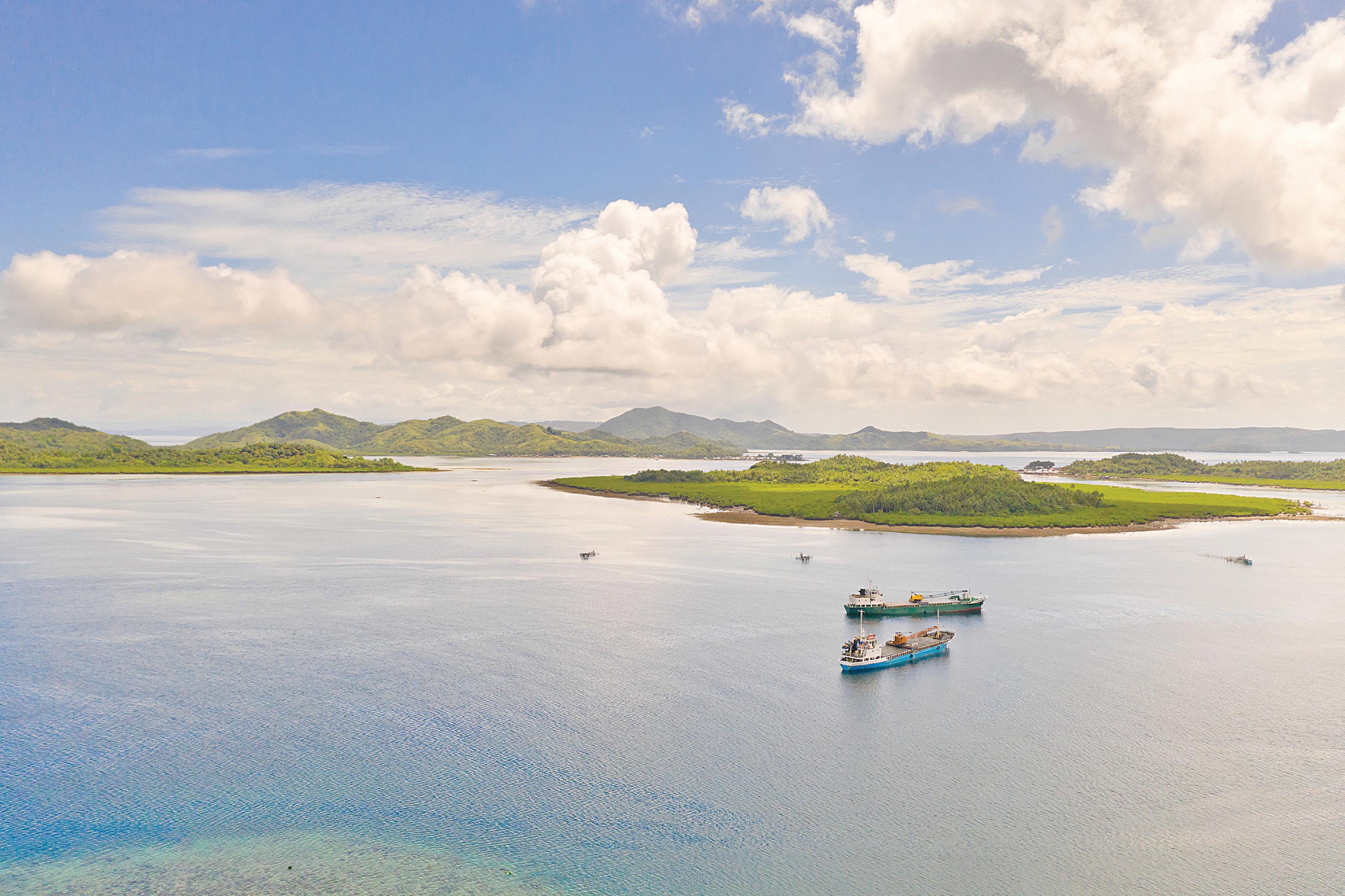







By Samuel P. Medenilla
YEONGJU, South Korea—Despite the existing maritime territorial dispute between Manila and Beijing, President Ferdinand Marcos Jr. and Chinese President Xi Jinping have “united” in calling for the “restoration” of global trade mechanisms at the 32nd Asia-Pacific Economic Cooperation (Apec) summit.
FBy Lorenz S. Marasigan
OR an archipelago like the Philippines, the sea is both lifeblood and barrier—thousands of kilometers of beautiful and majestic coastlines simultaneously connect and divide the nation.
More than two decades ago, that division felt more real than the connection. Interisland travel meant slow cargo lines and unreliable schedules. Back then, the markets were fragmented, and the water between islands often functioned more like borders than highways.
The government, however, attempted something bold: to transform water from obstacle into artery. The Strong Republic Nautical Highway (SRNH), a roll-on/roll-off (RoRo) network, fundamentally changed how Filipinos move between islands.
Before the nautical highway, interisland shipping measured delays in days rather than hours. A truck moving goods from Luzon to Mindanao might spend more time waiting at docks than traveling on actual roads.
The RoRo concept changed everything through simplicity. The idea was straightforward: treat the sea like asphalt, let trucks drive onto ferries in Luzon and roll off in Mindanao, and the entire country could function as a single market. From commerce to infrastructure THE Philippines has since shifted its view of maritime transport —

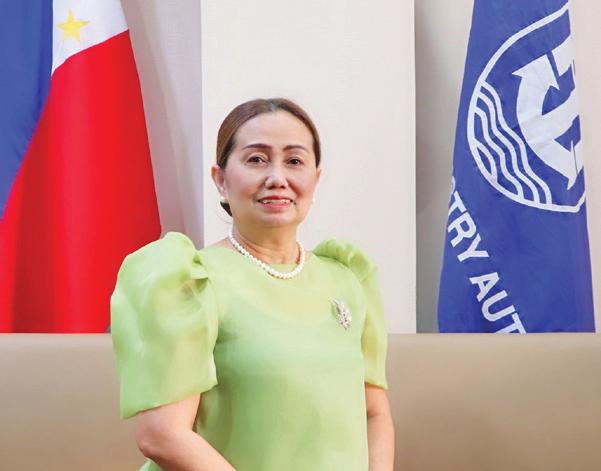

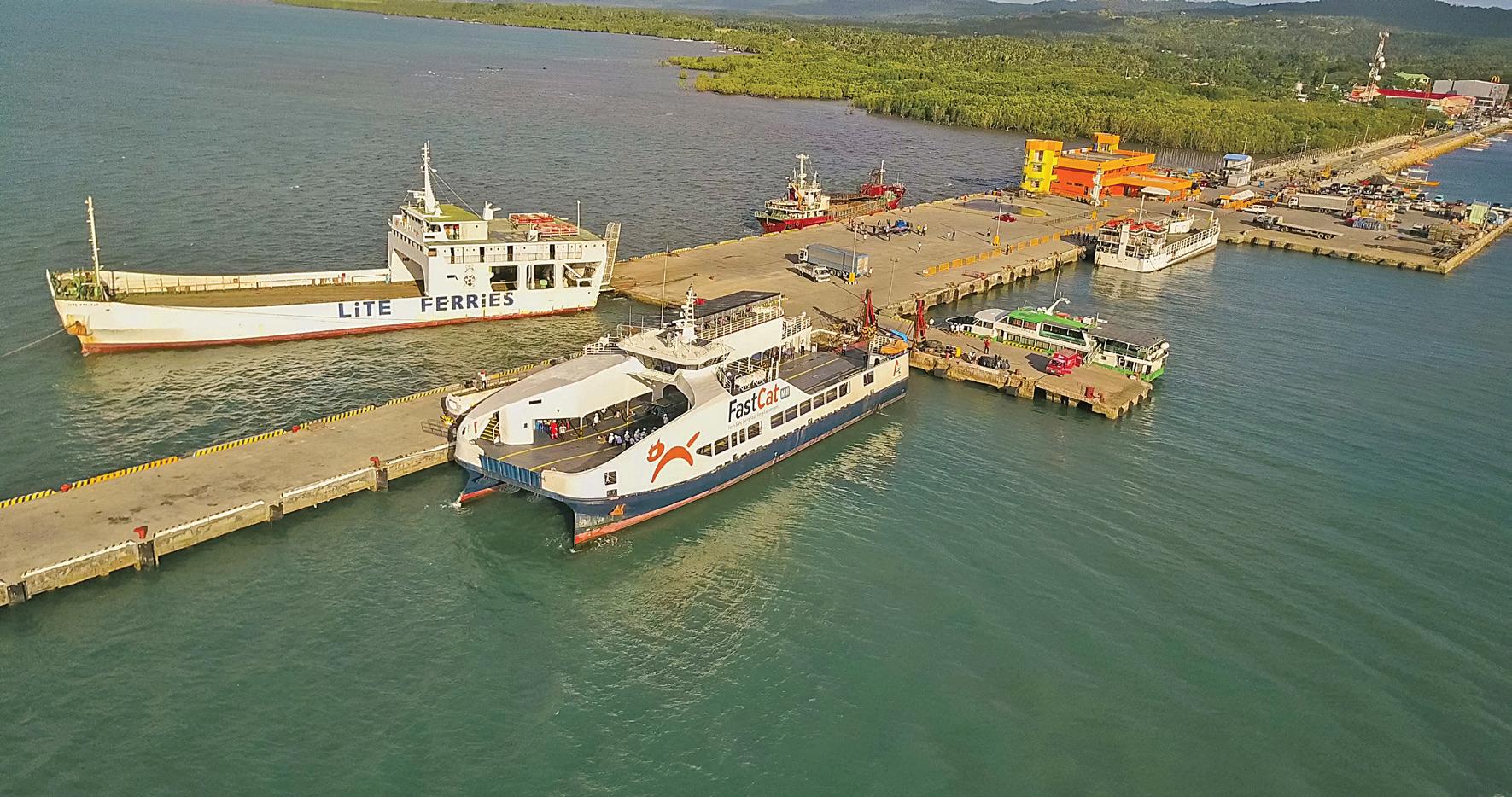
from commerce to infrastructure. And it worked.
“It created what we now call a ’connected archipelago,’ linking Luzon, Visayas, and Mindanao through roll-on/roll-off routes,” Maritime Industry Authority (Marina) Administrator Sonia Malaluan said. “That network helped small and medium shipping operators thrive, cut logistics costs by around 30 percent, and opened new trade and tourism corridors that remain vital today.”
According to a study conducted by the Asian Development Bank (ADB), the program transformed domestic logistics and local economies by cutting transport costs between 10 percent and
60 percent and slashing delivery times, thanks to the RoRo system that eliminated costly cargo handling and wharfage fees.
These efficiency gains allowed companies to streamline supply chains—consolidating warehouses and shifting to frequent, direct deliveries that reduced spoilage and made operations more predictable.
The nautical highway, according to the multinational lender, ignited growth in once-isolated areas, making ports economic catalysts by spurring commerce, creating tourism corridors, and democratizing access for farmers to major markets.



In his intervention at the Apec Economic Leaders’ Meeting Informal dialogue at the Hwabaek International Convention Center in Gyeongju, South Korea, on Friday, the chief executive called for the full restoration of dispute settlement powers of the World Trade Organization (WTO) to stabilize global trade. Related story from Apec on page A16.
He said the initiative will help address global trade uncertainty due to “intensifying geopolitical tensions, technological disruptions, supply chain vulnerability, protectionism, and even unwarranted economic competition.”
In the same event, Xi also called for the safeguarding of the true multilateral trading system to ensure inclusive economic globalization.
The absence of the WTO interventions on trade disputes, Marcos said, is more detrimental for small economies.
“Without a functioning dispute settlement mechanism, small economies would be at a disadvantage. For small economies, rules are a potent equalizer,” Marcos said.
The WTO, he said, will play a crucial role as the “stability of the global economy is being challenged.”
A report from the BusinessMirror in August noted that the appellate body of the dispute settlement organization has been “crippled” since the
“The SRNH really did what it was meant to do. It connected people and markets. Travel times between islands dropped by as much as 40 percent, tourism flourished, and we saw over a hundred RoRo routes linking a number of provinces since 2019. This is a huge step toward inclusivity in an archipelagic country like ours. It made maritime transport part of everyday life, not just a sector for cargo and commerce,” Malaluan explained.
For the Philippine Ports Authority (PPA), the challenge was to match this connectivity with capacity. The agency partnered with the private sector to modernize the South Harbor and the Manila International Container Terminal to handle larger cargo vessels, extending berths, expanding yards, and introducing bigger cranes. Those changes re-anchored Manila as a logistics hub while complementing the highway’s promise of “seamless mobility.”
The rise of expressways such as the South Luzon Expressway and the North Luzon Expressway further compressed travel time between ports and production zones.
So when the 2014 truck-ban crisis choked the capital, Batangas and Subic— linked by the expressways — absorbed diverted cargo and proved how a decentralized port network could rescue the supply chain.
Rewriting the rules
THE physical transformation of the nautical highway demanded le-
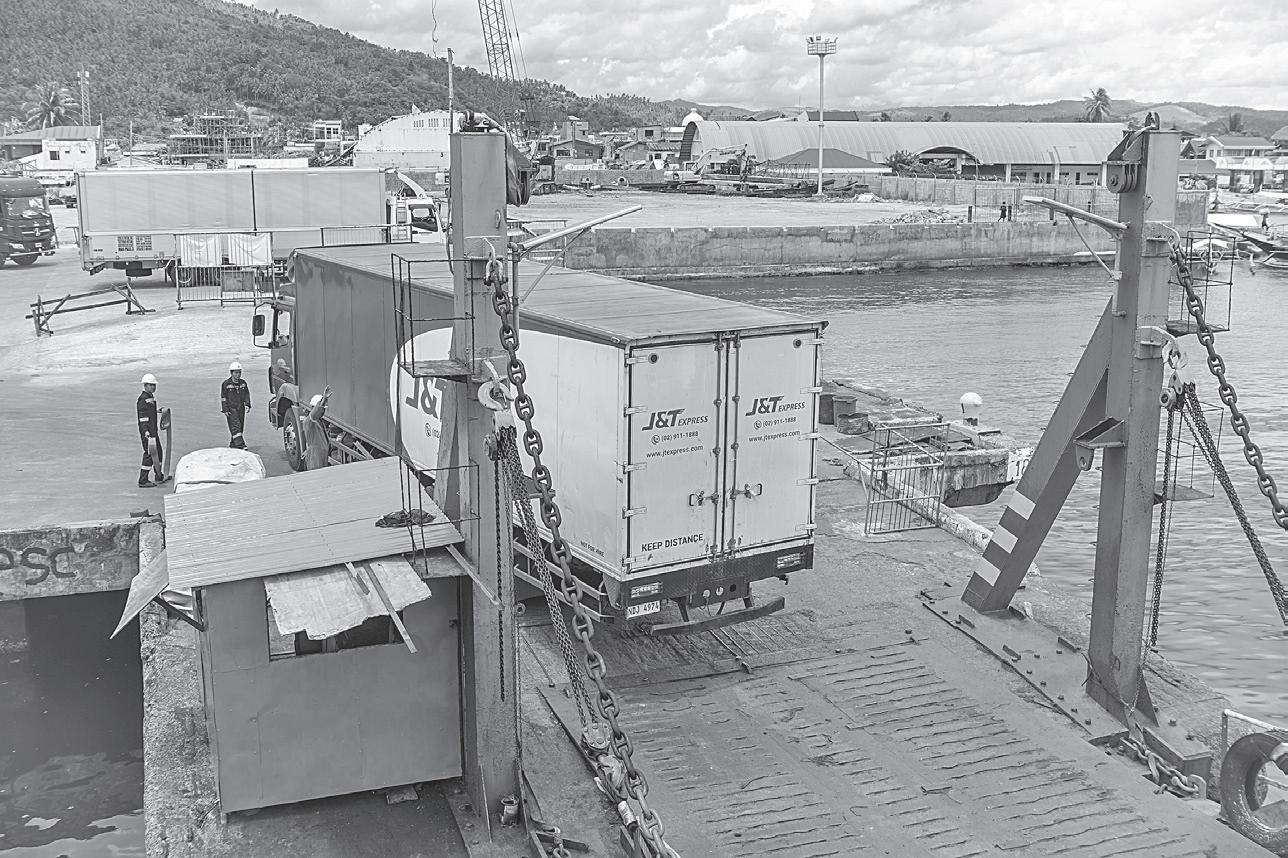
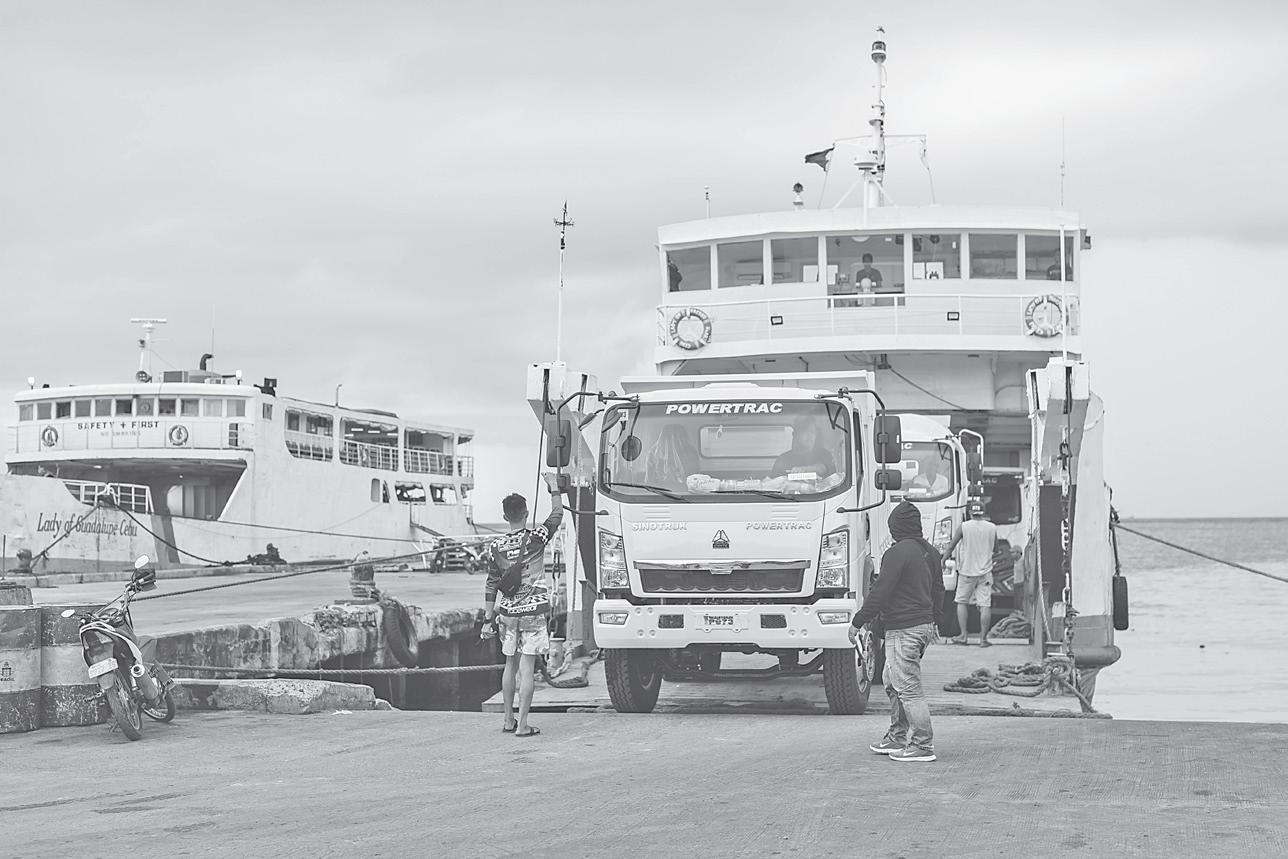
gal and regulatory reworks. Without it, the network would have remained a collection of disconnected routes rather than a national system.
The Domestic Shipping Development Act, passed the same year the highway launched, broke apart the route monopolies that had long stifled competition. Suddenly, smaller operators could enter markets that had been closed to them.
A decade later, another legislative shift consolidated the regulatory framework. The 2014 law that brought all seafarer training and certification under Marina’s umbrella created a single point of accountability for international compliance.
Before that consolidation, standards varied, documentation
was scattered, and oversight was inconsistent. After it, the Philippines had one voice speaking to the international maritime community.
That unified voice mattered most when it was tested. Between 2020 and 2023, the European Union (EU) conducted a comprehensive audit of Philippine maritime standards.
The stakes were high: failure could have meant Filipino seafarers losing access to EU-flagged vessels, threatening the livelihoods of hundreds of thousands of workers.
In response, Marina rebuilt systems, implementing risk-based audits, while creating modern digital systems to ensure strict compliance to international standards.
The Philippines passed the au-

dit. More significantly, it demonstrated that a developing country could meet first-world maritime governance standards.
“But beyond compliance, that experience showed us the importance of sustainable leadership and institutional continuity. Marina has faced frequent leadership changes, expanding mandates, and tight budgets. Yet through lean resources, we managed to push through reforms, digitize systems, and strengthen international cooperation. That’s something we’re proud of,” Malaluan said.
In 2022, the Amended Public Service Act (RA 11659) opened shipping and logistics to greater foreign equity, inviting new capital and technology.
Two years later, Executive Order No. 55 made the Maritime Industry Development Plan 2028 the government’s official roadmap, binding fleet modernization, digital transformation, and environmental stewardship into a single strategic framework.
Digital ports WHILE laws changed on paper, ports changed on the ground. Mostly under the term of PPA General Manager Jay Daniel Santiago, the agency spent two decades evolving from an operator of docks into a manager of logistics systems.
The Port Terminal Management Regulatory Framework, introduced in 2016, established transparent rules for how ports could be privatized and operated.
Follow-up orders in 2022 standardized everything from realestate management to how private and energy-related facilities would be regulated.
By 2024, at least 29 ports had been modernized and bid out under these frameworks. Many of them were RoRo terminals designed specifically to support the nautical highway that had started the entire transformation two decades earlier.
But hardware alone couldn’t solve port congestion problem. The ports needed to digitalize.
The Terminal Appointment Booking System, pioneered by International Container Terminal Services Inc. (ICTSI) of billionaire Enrique K. Razon, let truckers reserve time slots to enter terminals.
Likewise, the PPA’s Electronic Payment Portal eliminated another source of friction: cash transactions that invited delays and, occasionally, corruption. Everything became trackable, transparent, time-stamped.
Still in development are two
even more advanced systems. According to Santiago, the government is currently developing the Port Community System (PCS) and the Maritime Single Window (MSW).
“The proposed PCS and MSW will enable real-time data sharing among stakeholders—reducing documentation time, standardizing compliance, and facilitating faster vessel turnaround,” he explained.
Painting the ports green WHILE ships criss-cross Philippine waters burning diesel, the ports they dock at have begun turning green. The Port Environmental Policy, mandated in 2018, requires all port activities to minimize ecological impact and align with sustainability goals.
Santiago said that the Green Port Awards System encouraged ports to install shore-based power systems — “cold ironing” — that let docked vessels shut down their engines and draw electricity from land instead.
Other changes are simpler but cumulative: solar-powered lighting, LED retrofitting, rainwater harvesting, tree parks inside port grounds.
Marina, for its part, is rolling out the Maritime Energy Demand Information and Analysis Software (Medians), which will establish baseline data for ship emissions, helping the government set targets and incentives for energy-efficient vessels.
For Malaluan, digitalization and decarbonization “go hand in hand,” that’s why Marina is also rolling out the Blockchain Enabled Certification System nationwide, which will unify ship registration, licensing, and safety certification as well as other ship-related issuances.
“By 2027, we expect Marina to be operating fully as a data-driven regulator, where policy decisions are informed by analytics, and compliance monitoring happens in real time. That’s how we’ll make regulation smarter, cleaner, and more forward-looking,” she said.
Aging fleet, greening vessels
ALL of this progress — the nautical highway, the regulatory reforms, the port modernization, the digital systems, the environmental initiatives — rests on a foundation that’s quietly crumbling.
According to Malaluan, 60 percent of the domestic fleet is aging rapidly. The average vessel sailing Philippine waters is 24 years old.
“Fleet renewal has lagged behind, the average vessel age is still around 24 years, and financing op -
tions remain limited for smaller players,” she lamented.
For most operators, building or buying new ships isn’t easy. A new ship costs between $20 million and $80 million.
Many domestic operators are small or medium-sized businesses without that kind of capital. Banks, wary of the maritime sector’s volatility and the industry’s history of disasters, are reluctant to extend the long-term financing that ship purchases require.
The pandemic made everything worse. Trade slowed. Capital flows dried up. Ships that should have been replaced kept sailing because there was no alternative.
Malaluan said the agency is now courting development institutions and pushing for the passage of the Philippine Shipbuilding Development Bill that would revive local shipyards and create technology partnerships. It has revised its Pioneer Status Circular to offer incentives for operators who buy brand-new, internationally-classed RoRo passenger ships.
“Ultimately, modernization isn’t just about ships—it’s about enforcement and consistency. We’re phasing out obsolete vessels, rationalizing routes, and rewarding compliance. Fleet renewal takes investment, but it also takes trust in the system. That’s what Marina is trying to rebuild,” Malaluan assured.
But the aging fleet isn’t just a financial problem — it’s an environmental one. While ports install solar panels and shore power, the ships themselves remain stubbornly carbon-heavy.
Malaluan noted that Marina is piloting hybrid-electric routes between Batangas, Caticlan, and Iloilo under the National Green Ship Program, calling it “our first steps toward decarbonized domestic shipping.”
The centennial dream DESPITE the constraints, the Philippine maritime industry is steering toward an ambitious future.
Malaluan said that by 2045, when the Philippine markets its centennial independence, 80 percent of the domestic fleet should meet international greenhouse gas standards.
“The Philippines will always be a seafaring powerhouse, but by 2045, I want us to be known not just for our seafarers—but for our innovation. We should be designing our own ships, exporting maritime tech, and running worldclass shipyards in places like Subic, Cebu, and Mindanao. That’s the kind of maritime economy we’re building,” she said.
She also envisions that every major island would be linked by an upgraded “Nautical Highway 2.0.”
“If passengers can sail safely, shipowners can invest confidently, and our seafarers can work with pride, then we’ve done our job,” Malaluan said.
The last 20 years have proven that an archipelago divided by water can function as a unified nation.
For an archipelago like the Philippines, the sea has proven it can be more lifeblood than barrier. Whether it remains that way depends on solving a problem that no amount of digital dashboards or green port awards can fix: the industry still needs ships it can afford to replace.
Continued from A1
United States has been apparently blocking the appointments of its new judges, preventing it from having a quorum.
US President Donald Trump initiated his so-called “Liberation Day” in April, imposing a minimum 10-percent tariff on almost all imports. The incident prompted many of the US trade partners, including the Philippines, to negotiate with the US for the lowering of the said tariff rates. The country was initially slapped with a 20-percent duty under the new tariff regime, but it was reduced to 19 percent after the country agreed to some concessions with the US in July. China was among the countries which retaliated by imposing its own tariffs on US goods, triggering the trade war between Washington and Beijing. Last Thursday, Trump met with Xi, where they agreed to roll back some of the trade restrictions they imposed.
Editor: Angel R. Calso

By Hyung-Jin Kim, Kim Tong-Hyung & Huizhong Wu The Associated Press
GYEONGJU, South Korea— Chinese leader Xi Jinping told Asia-Pacific leaders on Friday that his country would help to defend global free trade at an annual economic regional forum snubbed by US President Donald Trump.
Xi took center stage at the AsiaPacific Economic Cooperation summit that began Friday in the South Korean city of Gyeongju, as Trump left the country a day earlier after reaching deals with Xi meant to ease their escalating trade war.
This year’s two-day APEC summit has been heavily overshadowed by the Trump-Xi meeting that was arranged on the sidelines.
Trump described his Thursday meeting with Xi as a roaring success, saying he would cut tariffs on China, while Beijing had agreed to allow the export of rare earth elements and start buying American soybeans. Their deals were a relief to a world economy rattled by trade tensions between the world’s two largest economies.
Trump’s decision to skip APEC fits with his well-known disdain for big, multi-nation forums that have been traditionally used to address huge global problems, but his blunt dismissal of APEC risks worsening America’s reputation at a forum that represents nearly 40% of the world’s population and more than half of global goods trade.
Xi defends multilateralism “THE more turbulent the times, the more we must work together,”
Xi said during APEC’s opening session. “The world is undergoing a period of rapid change, with the international situation becoming increasingly complex and volatile.”
Xi called for maintaining supply chain stability, in a riposte to US efforts to decouple its supply chains from China.
Xi also expressed hopes to work with other countries to expand cooperation in green industries and clean energy. Chinese exports of its solar panels, electric vehicles and other green tech have been criticized for creating oversupplies and undercutting the domestic industries of countries it exports to.
It’s Xi’s first visit to South Korea in 11 years, and he’s scheduled to meet South Korean President Lee Jae Myung and new Japanese Prime Minister Sanae Takaichi separately on Friday.
APEC faces challenges
ESTABLISHED in 1989 during a period of increased globalization,
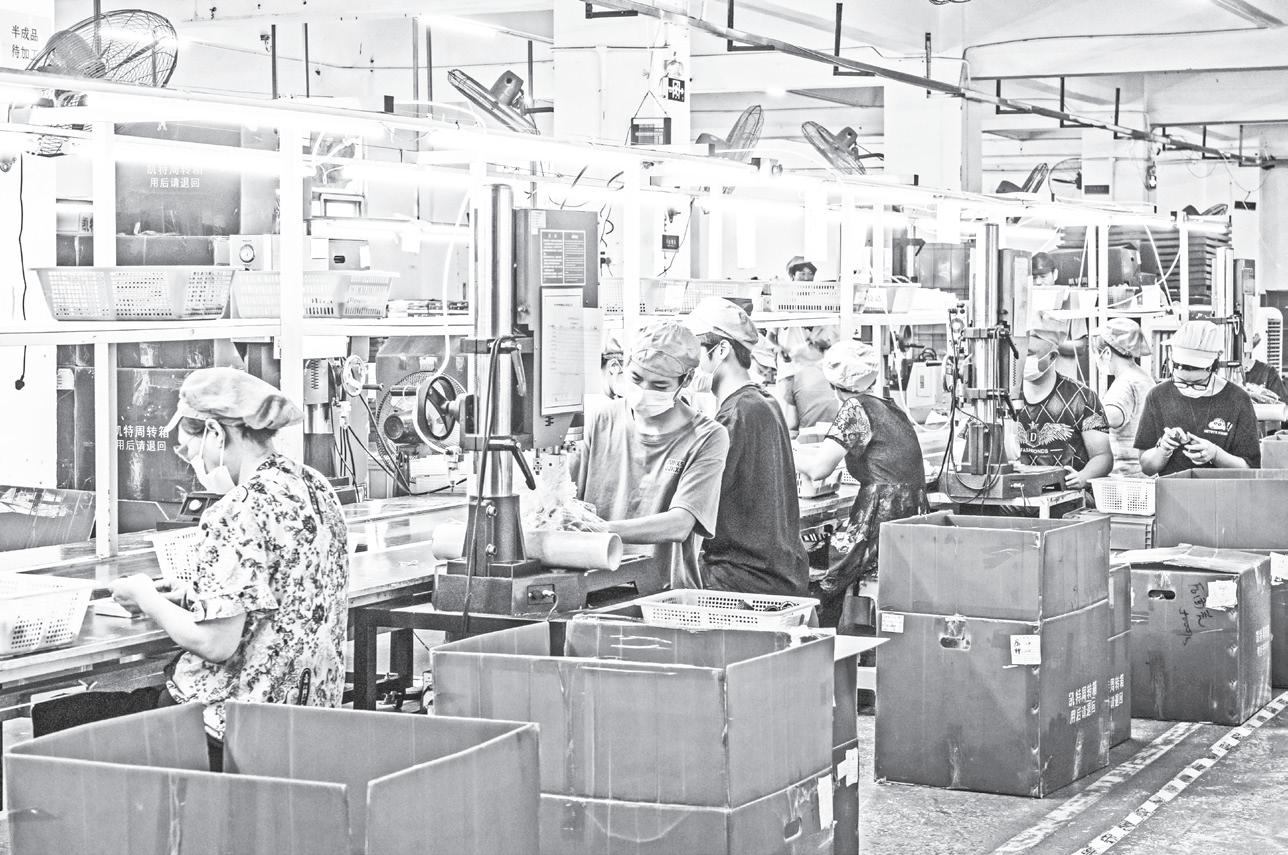
By Bloomberg News
HINESE exporters are heartened by
US tariffs following a summit between leaders of the two economic superpowers Thursday, but say they’re still keen to hedge exposure to any future setbacks in bilateral trade ties. For buyers and sellers alike of consumer goods in the US, the risks of relying solely on China for production for everything from fast fashion to holiday ornaments have begun to outweigh the country’s edge as a low-cost production hub. Even with the trade truce, US retailers aren’t likely
made
of his
Huang’s firm initially sought to lower that dependence on the US to just 20% with growth in other markets. An unexpected surge of sales before tariffs kicked in upended that goal this year, but shifting away from the US is “the only way to reduce trade risks for the long term,” he said. Chinese President Xi Jinping and US President Donald Trump announced the trade détente after their highly anticipated meeting in South Korea. If the 20% fentanyl tariff is halved, as Trump announced after the meeting, then the average rate on Chinese goods will fall to 31% according to Bloomberg Economics. That’s well below the 50% US tariffs on many products from Brazil and India—making production in See “Exporters,” A4
APEC champions free and open trade and investment to accelerate regional economic integration. But the APEC region now faces challenges like strategic competitions between the US and China, supply chain vulnerabilities, aging populations and the impact of AI on jobs. The US strategy has been shifted to economic competitions with China rather than cooperation, with Trump’s tariff hikes and “America first” agenda shaking markets and threatening decades of globalization and multinationalism.
Leaders and other representatives from 21 Asia-Pacific Rim economies are attending the APEC meeting to discuss how to promote economic cooperation and tackle shared challenges. Opening the summit as chair, Lee called for greater cooperation and solidarity to overcome new challenges.

“It’s obvious that we can’t always stand on the same side, as our national interests are at stake. But we can join together
for the ultimate goal of shared prosperity,” Lee said. “I hope we will have candid and constructive discussions on how we can
achieve APEC’s vision in the face of the new challenge of a rapidly changing international economic environment.”
Despite Trump’s optimism after a 100-minute meeting with Xi, there continues to be the potential for major tensions between the countries, with both seeking dominant places in manufacturing and developing emerging technologies such as artificial intelligence.
“It is certainly a contribution to bring the leaders of the two largest economies together for a meeting where they agreed to withdraw their most extreme tariff and export control threats. As a result, worst-case outcomes for global trade were averted,” said Leif-Eric Easley, professor of international studies at Ewha Womans University in Seoul.

KUALA LUMPUR, Malaysia— Malaysia called Friday for fellow members of the Association of Southeast Asian Nations to extend their security partnerships from the high seas to cyberspace at an annual meeting of the bloc’s defense ministers.
Defense Minister Mohamed Khaled Nordin opened the meeting by warning that regional peace faces growing pressure from both traditional and emerging threats, including rising tensions in the disputed South China Sea and the spread of cyberattacks that can “disrupt societies, topple governments and undermine critical infrastructure.”
“Threats today transcend borders and dimensions,” he said. “We see the challenges in the South China Sea. But we must also recognize that our digital realm is equally at risk. The threats that test our networks and systems may be invisible, but just as dangerous as those threatening our maritime zones.
Asean defense ministers will hold talks Saturday with dialogue partners including the United States, China, Japan,
Continued from A3
India, Australia, South Korea and Russia. Among those attending are US Defense Secretary Pete Hegseth, who arrived late Wednesday, and his Chinese counterpart Dong Jun. Hegseth and Khaled held a bilateral meeting Thursday and reaffirmed the US and Malaysia’s commitment to maritime security in the South China Sea, according to a joint statement issued Friday.
In an apparent swipe at China, Khaled said in the statement that “grey-zone tactics, such as hydrographic research conducted under the protection of foreign coast guard vessels, threaten sovereignty and are a clear provocation and threat.” Malaysia has previously protested the encroachment of Chinese vessels into its waters but usually prefers quiet diplomacy. That’s in contrast to the neighboring Philippines, which has had

major confrontations with China at sea in recent years.
Both Khaled and Hegseth agreed that “respect for sovereignty is imperative” in the waterway, the statement added. China claims virtually the entire South China Sea, overlapping claims made by countries including Malaysia, the Philippines, Vietnam and Taiwan.
In his speech Friday, Khaled also urged all Asean members to expedite the formation of an Asean observer team to support Thailand and Cambodia in resolving their border crisis. The two nations inked an expanded ceasefire pact on Sunday, witnessed by US President Donald Trump and Malaysian
Prime Minister Anwar Ibrahim, who is this year’s Asean chair. Khaled also reiterated Asean’s commitment to support a peaceful resolution of the civil war in Myanmar, saying the bloc remains determined to help the country “return to its rightful place in Asean.” Myanmar military government leaders have been barred from Asean meetings after failing to comply with the bloc’s 2021 Five-Point Consensus on peace and dialogue. Myanmar has been gripped by conflict since a military takeover in 2021 ousted its elected government, sparking widespread resistance and international condemnation. AP
By Eléonore Hughes The Associated Press
RIO DE JANEIRO—Fam
-
ilies of the scores of people killed in a deadly gang raid by Rio de Janeiro police began burying the dead on Thursday, with residents left reeling by the scenes of carnage and livid at law enforcement whom they accuse of excessive force, torture and extrajudicial killings.
In the Vila Cruzeiro favela, where the bodies were lined up next to one another a day prior, many voiced their shock, grief and anger as government ministers and lawmakers came to hear the demands of the community.
At least 132 people were killed during Tuesday’s operation, including four policemen, according to a Thursday tally by Rio de Janeiro’s public defenders’ office.
A day after a raid that many described as feeling like a war, the low-income neighborhood showed signs of a return of everyday activities, with a few restaurants and shops once again awaiting customers.
“I came to work because I have to, but my mental health is shattered,” said Monique Santiliano, a 40-year-old local who runs a nail salon in front of the favela rights’ group CUFA in Vila Cruzeiro, part of the sprawling Penha complex of urban communities.
Gov. Claudio Castro to provide detailed information about the operation.
Supreme Court Justice Alexandre de Moraes scheduled a hearing with the state governor and the heads of the military and civil police next Monday in Rio.
While some in Brazil, particularly right-wing voters and politicians, applauded the operation against the heavilyarmed gang, others questioned whether it would achieve lasting results and argued that many of those killed were low-ranking and easily replaceable.
Otoni de Paula, a conservative lawmaker, told The Associated Press on Thursday that the disparity between the number of deaths of police officers and of suspects at the very least raises questions.
“I think we’re dealing with an ambush whose sole objective was execution,” he said. “We cannot think that the state can grant the police the right to kill anyone.”
Residents decried the state of the bodies, with at least one decapitated, while others reportedly found with puncture wounds or tied up.
“However, APEC is meant to be more than a venue for a trade war truce,” Easley said. “Greater multilateral efforts are needed to address the region’s most pressing economic challenges, including resisting costly and destabilizing protectionism, harmonizing regulations for sustainable trade, and coordinating standards for digital innovation.”
China more attractive than either, at least for now, especially after taking into account its mature manufacturing ecosystem and vast pool of trained workers.
Several Chinese exporters Bloomberg News spoke with were optimistic the improved trade relations will result in an uptick in order flow between the world’s largest economies, bolstering profitability for businesses that have been squeezed by US tariffs of more than 50% in recent months on imports from China.
“We are going to get better deals with US clients,” said Andre Huang, a sales manager working for a firm selling household
Host South Korea pushes for joint statement SOUTH Korean officials said they’ve been communicating with other countries to prod all 21 members to adopt a joint statement at the end of the summit so as not to repeat the failure to issue one in 2018 in Papua New Guinea due to US-China discord over trade.
cleaning products like mops from Ningbo, an export base in eastern China.
The company’s expansion in the US has been stalled by the high tariffs imposed earlier in the year, but Huang noted things have started to brighten up lately amid growing expectations for a breakthrough at the Trump-Xi summit. He said more American clients showed up for a trade fair currently being held in Guangzhou than did for a similar event just a few months ago.
Lessons learned YET the prospect of more business in the US no longer excites Chinese exporters as it once did. Many said they’ve learned their lessons from Trump’s trade brinkmanship and now realize they can’t rely solely on access to the world’s biggest consumer market.

South Korean Foreign Minister Cho Hyun said last week that issuing a joint statement strongly endorsing free trade would be unlikely because of differing positions among APEC members. He instead anticipated a broader declaration emphasizing peace and prosperity in the region.
As host nation, South Korea places a priority on discussing AI cooperation and demographic
The push into markets beyond the US already is evident in China’s trade data.
The country is on track for a record $1.2 trillion trade surplus this year as shipments to Europe, Africa and other parts of Asia offset a slump in exports to the US.
At the same time, many buyers in the US have begun to rethink their dependence on a China-based sourcing strategy. They’re asking suppliers to set up manufacturing operations outside of China, even if it means higher costs and lower efficiencies in the near term.
For Lin Qian, who runs factories making toys in both the southern China boomtown of Shenzhen and in Vietnam, the lower US levies mean his Chinese factories will continue to handle the bulk of orders from US clients in the near term. But longer-term,
challenges such as aging population and low birth rates, under the theme “Building a Sustainable Tomorrow: Connect, Innovate, Prosper.” South Korean officials say APEC members will share exemplary cases of responses to AI and demographic issues, explore common steps and formulate new growth strategies during this week’s summit.
Wu reported from Taipei, Taiwan.
he sees a shift away from China to steer clear of further disruption.
“Both us and our clients are clear the diversification pace won’t change as the China-US relationship is still tricky,” he said.
Establishing a production facility in nearby Vietnam is non-negotiable for a company that counts US toy brands for three-quarters of its revenue. Those clients, who Lin wouldn’t specify, threatened to stop placing orders altogether earlier this year unless he moved more production to the Southeast Asian country.
Production at Lin’s toymaking factory in Vietnam finally kicked off in September, three months later than expected.
“Challenges are obvious,” he said, adding “we really have to leave our comfort zone.” Bloomberg News
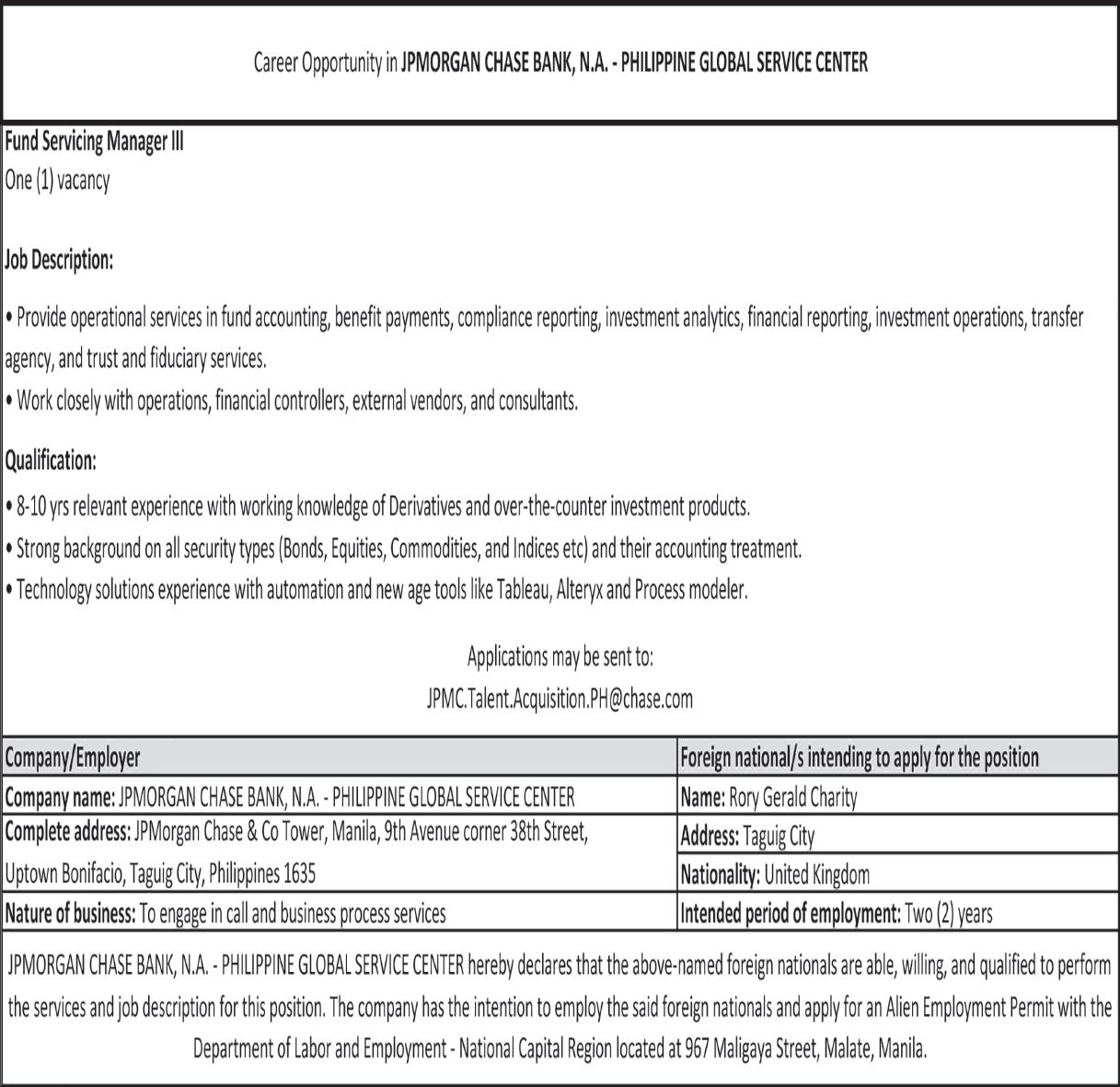
“This wasn’t an operation, these were assassinations. They didn’t come to arrest, they came to kill,” Santiliano added, her voice shaking.
Conservative Rio state Gov. Claudio Castro said on Tuesday that Rio was at war against “narco-terrorism,” a term that echoed the Trump administration in its campaign against drug smuggling in Latin America. He called the operation a success.
Human Rights Minister Macaé Evaristo told residents and journalists gathered in Penha that she did not accept that claim and that the fight against organized crime should target masterminds and financiers.
“There’s no point in coming into our communities and exposing children, the elderly and people with disabilities to such terror,” she said.
Tuesday’s raid, conducted by some 2,500 police and soldiers, targeted the notorious gang Red Command in the Complexo de Alemao and Complexo da Penha favelas. It drew gunfire and other retaliation from gang members, sparking scenes of chaos across the city on Tuesday.
The state government said those killed were criminals who resisted the police.
But the death toll, the highest ever in a Rio police operation, sparked condemnation from human rights groups, the UN and intense scrutiny from authorities. Brazil’s Supreme Court, prosecutors and lawmakers ordered Rio state
“This brutality cannot be normalized just because it happened here. If the country continues to applaud, it will happen elsewhere,” said Ana Tobossi, an activist and local resident. Tobossi said she was struggling even more on Thursday following the adrenaline rush the day before, when she went to the green ridge area where many of the bodies were found early Wednesday morning to help in the search.
“Now comes a sense of great fragility,” she said.
The operation’s stated objectives were capturing leaders and limiting the territorial expansion of the Red Command gang, which has increased its control over favelas in recent years. The organized crime group has also expanded its presence across Brazil in recent years, including in the Amazon rainforest.
Paulo Roberto, a 16-year-old who works as a street vendor at the famed Maracana football stadium, said that he had been left shaken by events.
“People from outside are going to see this going on in favelas and aren’t going to want to come anymore. It makes us look bad,” he said. By Thursday, some families had begun burying their dead. A police officer was buried in the morning in Rio’s western zone.
After the funeral of 22-yearold Cauan Fernandes do Carmo Soares, who lived in Complexo de Alemao, his relatives followed his coffin to a nearby cemetery in Rio’s northern zone carrying white flowers.
“These boys have a father, a mother, sisters and brothers,” said Grasiele, Fernandes do Carmo Soares’ sister, before the wake. “My family is destroyed.”


By Clement Dionglay
LONGYEARBYEN, Norway—The Philippine Rice Research Institute (PhilRice) has made a historic, firsttime deposit of 4,417 samples of Filipino rice, including important traditional and climate-resilient varieties at the Svalbard Global Seed Vault in Norway.
The samples from PhilRice were the largest shipment during the 68th deposit at the Global Seed Vault in October, which saw 20 genebanks worldwide contribute more than 21,000 seed samples to the Arctic facility, located deep inside the permafrost on the island of Spitsbergen.
Insurance for Filipino Staples
THE landmark action marks the first time in PhilRice’s 40-year history that the genebank has backed up its seed duplicates outside the Philippines.
By safeguarding the unique rice varieties—some of which include cherished traditional strains such as Dinorado and Milagrosa, known for their exquisite fragrance and soft texture—PhilRice is not just preserving seeds; it is protecting the essence of Filipino heritage, history, and culture.
The rice varieties are more than just agricultural products; they symbolize a deep-rooted connection to the land and
AWIN for forest heritage. The municipal government of Los Baños recognized the Xylarium, or wood collection, of the Forest Products Research and Development Institute’s (FPRDI) as a cultural treasure, recognizing its invaluable contribution to science, heritage, and environmental conservation.
The Los Baños Municipal Council on October 20 passed Resolution 2025-180, titled “A Resolution acknowledging the DOST-FPRDI Xylarium wood collection as a cultural heritage, science and technology, and tourism landmark of the municipality of Los Baños, Laguna, supporting its declaration as a national cultural treasure, and directing its inclusion in the official tourism promotions of the municipality.”
Councilor Muriel B. Dizon authored the resolution with Councilors Leren Mae Bautista and Myla Alinsunurin, the Department of Science and Technology-FPRDI said in a news release.
“This recognition strengthens the value of DOST-FPRDI’s wood specimens and also highlights the Filipino spirit of innovation and care for the environment,” said Science Secretary Renato U. Solidum Jr. “By safeguarding this collection, we are protecting the foundation for discoveries that can help shape Philippine forestry,” Solidum added.
the Philippines’ culinary legacy.
Ensuring their survival is crucial for future breeding initiatives, agricultural resilience, and, ultimately, food security.
“Safeguarding seed diversity at Svalbard provides vital protection against natural or man-made disasters, pests, diseases and accidents that could threaten our genebank in the Philippines,” said Jonathan M. Niones, division head and chief science research specialist at PhilRice.
The move establishes a crucial safety net for the Philippines, a country frequently exposed to extreme weather events, ensuring that the genetic blueprint of its most important food crop is conserved for future generations.
Other deposits to the Global Seed Vault from the Philippines IN June, the country’s national genebank, the National Plant Genetic Resources Laboratory (NPGRL) at the University of the Philippines Los Baños, led by University Researcher Hidelisa D. De Chavez, deposited 149 Philippine accessions of tomato, pepper and eggplant to the Global Seed Vault. It was NPGRL’s fifth deposit, bringing their total deposit to 3,461 accessions of 14 crop species.
The International Rice Research Institute (IRRI) made its first deposit to the Global Seed Vault in 2008, the year the vault officially

opened. This initial deposit included 70,180 rice seed samples. IRRI is one of the major international genebanks that regularly sends duplicates of its collection to the Vault.
Global call for urgency
THE Crop Trust, which manages the facility alongside the Norwegian government and NordGen, framed the event as a necessary moment of both celebration and urgency. While PhilRice’s efforts represent a significant step for national food security, the Crop Trust emphasized that many global crop diversity collections remain at risk due to limited resources.
Crop Trust Executive Director of the Dr. Stefan Schmitz urged governments to “step


up support so genebanks can continue and expand their vital work and help secure enough food and nutritious diets where they are needed most.”
The latest deposit brings the total number of seed samples secured in the Svalbard Global Seed Vault—the world’s largest backup repository of crop diversity—to over 1.3 million.
Doomsday seed vault
ALSO called the “Doomsday Global Seed Vault,” the Svalbard Global Seed Vault is the world’s largest backup facility for crop diversity. It stores duplicates of seeds from seed collections and gene banks from around the globe, kept for long-term
about authentic Filipino craftsmanship, while Local communities and individuals could have a tangible connection to the country’s natural history and shared identity through the wood collection.
Councilor Dizon highlighted the Xylarium collection’s role in linking Los Baños’ scientific identity with its cultural heritage.
According to her, Mayor Neil Andrew N. Nocon expressed his pride, saying, “Los Baños is proud to be home to a collection that bridges nature, science and culture. This recognition reminds us that sustainability and heritage go hand in hand.”
“The Xylarium stands as our commitment to keep knowledge alive so we can understand, restore, and protect the forests that sustain us,” said DOST-FPRDI Director Rico J. Cabangon.
storage to contribute to securing the world’s food supply.
The Global Seed Vault can store 4.5 million seed samples at negative 18 degrees Celsius (negative 0.4°Farenheit).
Established and owned by Norway, it is operated between the Norwegian Ministry of Food and Agriculture, the regional genebank NordGen and the Crop Trust, an independent international organization.
Seedboxes in the Global Seed Vault are stored under “black box conditions,” meaning the depositors retain ownership rights over the seeds that they sent, and they are the only ones who can withdraw their own seeds.
While the seeds are stored in the Global
Seed Vault, only NordGen personnel are allowed to handle the seed boxes.
Svalbard seed vault’s first withdrawal IN September 2015, the International Center for Agricultural Research in the Dry Areas (ICARDA) made the first and only withdrawal from the Svalbard Global Seed Vault, requesting their backup seeds due to the ongoing Syrian civil war. ICARDA, one of the first gene banks to deposit duplicates in the Vault, had historically housed the largest collection of crop diversity from the Fertile Crescent in Aleppo, including valuable varieties of wheat, barley, and legumes. After the armed conflict jeopardized their original gene bank in 2011, ICARDA deposited over 14,000 accessions as a safety measure.
The 2015 withdrawal, managed from their new base in Beirut, Lebanon, was necessary to restart their essential research collection away from the conflict. Since 2016, ICARDA has been successfully regenerating and distributing samples from these seeds, actively working to fully reconstruct its historic collection in new locations in Lebanon and Morocco. Clement Dionglay
SEARCA, UPLB-Biotech lead dialogue to accelerate registration of microbial-based products in academe
LOS BAÑOS, Laguna—In a move to drive innovation and regulatory responsiveness in agricultural biotechnology, the Southeast Asian Regional Center for Graduate Study and Research in Agriculture (Searca) and the University of the Philippines Los Baños (UPLB) National Institute of Molecular Biology and Biotechnology (Biotech) recently coorganized a high-level forum.
The forum on “Bridging Biotechnology Innovation and Regulations: Orientation on Microbial-based Product Development and Commercialization in the Academic Setting” held at Searca brought together 58 agri-biotech stakeholders from academic institutions, government regulatory bodies, and the private sector.
full support to researchers “in their efforts to explore streamlining in the regulatory process for technologies developed in the academic setting.”
Experts from UPLB highlighted both the achievements and challenges in the commercialization pathway.
Dr. Mannix Pedro, deputy director for Research, Development, and Extension at UPLB-Biotech, detailed the institute’s track record in developing over 50 biotech products and technologies—including microbial-based inoculants such as Bio N, NitroPlus, NitroLink, Biosol-P, PhosphoLink, Oryzinc, Maizinc, K-SolB, Mykovam, and MykoPlus.
Discussed were practical solutions for streamlining the approval and registration of microbial-based products developed in academic settings.
The DOST-FPRDI is currently preparing the necessary documentation for submission to the National Commission for Culture and the Arts for its application to declare the Xylarium as a national cultural treasure. Located within the DOST-FPRDI compound, the Xylarium, or “Wood Library,” houses thousands of wood specimens representing about 98 percent of known Philippine tree species, including some that are now extinct and others collected as early as the 1900s. The word xylarium comes from the Greek word xylon (wood) and the Latin arium (place).
By John Eiron R. Francisco
BACOLOD CITY—The Science and Local Government departments signed a Memorandum of Understanding (MOU) to help communities nationwide better prepare for climate- and disaster-related risks by strengthening local innovation and disaster resilience.
“We are proud to stand with the Department of Science and Technology [DOST] in strengthening disaster preparedness across all local governments in the country, particularly here in the Visayas region,” DILG Undersecretary for Local Government Marlo Iringan said during the signing ceremony at the HANDA Pilipinas Visayas Leg. Iringan highlighted the Philippines’ vulnerability, noting that the country remains one of the most disaster-prone nations in the world.
“This is a sobering truth, but also a strong reminder of our duty to act with urgency and collaboration,” he said.
“Preparedness must not only be a program,
Beyond its scientific value, the collection underscores the Institute’s long-standing commitment to forest conservation, research,
but a way of governance and a way of life.”
He explained that, through the operations of the science department, local governments are provided with the knowledge, systems, and tools they need to protect their communities.
“As DOST leads this effort, we shall bring science and innovation directly to our local governments,” Iringan said. “Together, we are building a government that listens, collaborates, and uses innovation not just for efficiency, but for empathy.”
He emphasized that tools and technologies are effective only when local officials use them properly. Resilience and preparedness, he added, depend largely on the capacity of local governments to identify programs that genuinely address community needs and to allocate resources efficiently.
‘LGUs strengthen disaster response’ IRIGAN meanwhile, reported that the DILG monitors the completion of 168 evacuation centers across 134 local government units
and responsible resource management.
The wood collection is an indispensable reference for those working to understand, use, and preserve the country’s forest resources.
For scientists, it is a treasure trove of data for taxonomy, climate studies, and forest restoration research. It offers crucial insights to anthropologists into traditional knowledge, resource use, and the shifting cultural landscape of the Philippines.
Meanwhile, for artisans and industries, the wood specimens can provide information
(LGUs), which now serve as safe shelters for families during disasters.
Based on the 2024 Seal of Local Governance Assessment, out of 1,724 LGUs, 1,426 have functional Local Disaster Risk Reduction and Management (LDRRM) offices; 1,429 have approved disaster risk reduction and climate change adaptation plans; 1,472 maintain early warning systems; and 1,494 operate incident command systems.
“LGUs that have not yet met the standards will continue to receive support from the DILG, DOST, and other science agencies,” he added.
“These numbers represent thousands of local frontliners and community workers who strive to keep their people safe,” he said, urging LGUs to continue strengthening their preparedness and resiliency initiatives.
Iringan also highlighted developments in emergency response. On September 11, the government launched a unified 911 system, a nationwide hotline linking police, fire, jail, and local government responders, with the aim of improving
“By honoring this collection, we ensure that future generations will inherit not just pieces of wood, but knowledge, history, and the shared responsibility to keep the country’s forests thriving,” he added.
According to Cabangon, plans are already underway to make the collection more accessible to the public through guided tours, educational exhibits, and digital archives, among others.
The FPRDI is a research and development arm of the DOST and is part of the government’s efforts to build a strong science and technology ecosystem in the country. The Institute continues to promote responsible forest use and biodiversity conservation through science-based innovation.
response times.
On October 25 in Cebu City, DILG and DOST officials inaugurated the Visayas hub of the 911 system, the first of five regional hubs planned nationwide. The system now allows caller tracking through SIM card registration and includes measures to improve the capacity of local government units to respond to emergencies.
He added that the Bureau of Fire Protection will be modernized with new fire trucks, patrol vehicles, emergency rescue equipment, and motorcycles to enhance disaster response.
“This is a test for us to modernize our system with the software component. There is no capability for those on the ground to respond. So we are improving the capacity of our responders,” he added.
‘Bacolod prepares for floods’ ALONGSIDE the national MOU, the Bacolod City government signed an agreement to establish a community-based flood early warning system (CBFEWS).
“Usually, LGUs receive data either
Dr. Mercedita Sombilla, Searca Center director, emphasized the role of regulation as an enabler, stating: “Regulation should not be a barrier; it should be a bridge—a bridge built with trust, clarity, and scientific integrity.”
Sombilla lauded the forum as a platform for open dialogue and collaboration among disciplines, reinforcing Searca’s commitment to advancing biotechnology in the region.
Dr. Marian De Leon, UPLB assistant to the Vice Chancellor for Research and Extension, expressed the UPLB Office of the Vice Chancellor for Research and Extension’s
Pedro noted that state universities and colleges and research and development institutes often face regulatory hurdles originally designed for commercial companies, complicating compliance for academic institutions.
Dr. Rodney Perez, UPLB-Biotech Scientist I and program leader for Food, Feed, and Specialty Products, underscored the need for regulatory reforms to address the unique circumstances of academic research institutions.
He shared his program’s experience in successfully developing 20 technologies, securing 23 intellectual property rights, and influencing two national policies, but cited challenges such as the lack of pilot-scale production facilities and stringent regulatory requirements for novel microbial-derived products.


THE 115-year-old Missionary Society of St. Paul (MSSP) marked a historic milestone with the ordination of its first Filipino priest.
Fr. Marco Cabatuando was ordained during Mass at the San Isidro Labrador Parish Church in Malhacan, a barangay in Meycauayan City, Bulacan, on October 18.
The rite, presided over by Bishop Dennis Villarojo of Malolos was joined by Cabatuando’s confreres, family, and friends.
The new priest, who spent 11 years in formation, described his ordination as “a thanksgiving to the Lord for all the people who have walked with me in faith, hope, and love throughout this journey.”
“My years of formation have ended, but this is just the beginning of new discoveries, new encounters, and new miracles of God’s grace in priestly ministry,” he said. “Please continue to pray for me that I may always serve with a humble heart, a listening spirit, and a joyful soul.”
He added that the gift of priesthood “is only the beginning of a lifelong mission,” and asked the faithful to pray for missionaries to “remain faithful to their vocation and zealous in the missions God has entrusted to them.”
The celebration drew MSSP leaders and members from across the region, including Fr. Martin Galea,
the congregation’s superior general, and Fr. Hector Attard, provincial superior of the MSSP VietnamPhilippines Province.
The ordination also coincided with the MSSP’s 25th year of missionary presence in the Philippines.
Two weeks earlier, the congregation also celebrated in Vietnam with the ordination of its first Vietnamese priest.
“And now here, the first Filipino,” Galea said. “We truly feel very blessed… [Though] we are a small congregation born on a small island, the Lord continues to bless us with young members who bring new life to our community.”
“We look forward for more and more vocations. We look forward for many people who feel inspired, that they feel the courage to say ‘yes’ as well,” he added.
Founded in Malta in 1910 by Msgr. Joseph De Piro, the MSSP began its mission in the Philippines in 1999, initially serving in parishes and campus ministry at the Polytechnic University of the Philippines.
Recognizing the country’s strong potential for religious vocations, the congregation established its International House of Formation in 2007, and inaugurated in 2009. By 2010, local formation had begun in New Manila— paving the way for the ordination of its first Filipino priest. CBCP News

By Minnie Abigail Agdeppa
ACATHOLIC bishop has voiced sadness over the growing scarcity of priestly vocations, saying ordinations have become a “rare sight” not only in his diocese but across the country.
Speaking before a packed congregation at the Cathedral-Shrine of the Good Shepherd in Quezon City, Bishop Roberto Gaa said the Church faces a serious shortage of men willing to dedicate their lives to the priesthood.
“Ordinations have become a rare sight not only in Novaliches but also in other places because no one wants to become a priest anymore,” Gaa, who also heads the Catholic Bishops Conference of the Philippines Commission on Vocations, said in his homily.
“It is difficult to be a priest,” he added.
The bishop made the remarks as he ordained two new priests and two deacons in a Eucharistic celebration. The last priestly or -
dination in Novaliches was held about three years ago.
Gaa ordained Ramon Mikhail Paolo Nicdao and John Paul Adia to the priesthood, and Joshua Paul Sadernas and Michael George Villasis to the diaconate.
He said the shortage of priests has become a major pastoral challenge, with the diocese having only one priest for every 70,000 parishioners.
“We cannot minister to all of you,” he said. “But if we pray for more priests, more servants, then we can continue to share God’s graces with you.”
Recalling his years as a seminary formator, Gaa said many parents discouraged their children from entering
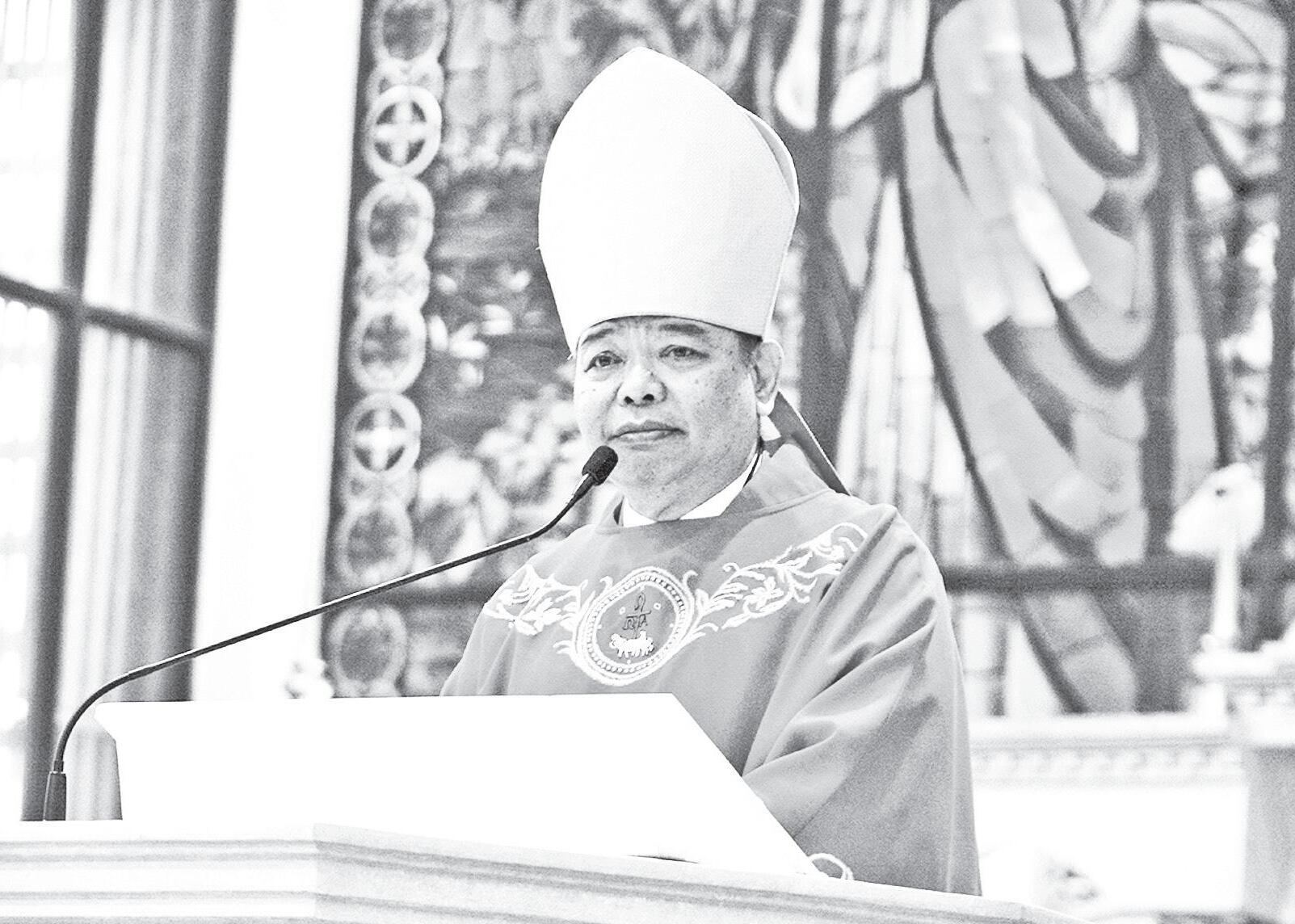
the priesthood despite sensing their genuine spiritual calling.
“When we visited the homes of candidates for the seminary, some parents would slam their doors on us,” he said. “They would tell us, ‘After we’ve supported them through college, now you’re taking them away from us?’”
Despite the challenges, the bishop emphasized that “God’s grace is always sufficient” for those who respond to His call.
“We are imperfect and that is
why we are for your prayers,” Gaa said. “We continually need the blessing of God for ourselves, for our ministry, and for our work in God’s vineyard.”
He appealed to the faithful to “pray for your priests” and “pray for new vocations even if the priesthood is difficult.”
The Novaliches diocese covers 73 parishes across northern Caloocan City and northern Quezon City, serving roughly 2.5 million Catholics. CBCP News
ACATHOLIC bishop has called on Filipinos to rediscover the true Christian meaning of All Saints’ Day and All Souls’ Day.
Bishop Renato Mayugba, who chairs the Catholic Bishops Conference of the Philippines Office for the Postulation of the Causes of Saints, said the occasion should be rooted in the Church’s faith in the communion of saints.
He stressed that All Saints’ and All Souls’ Days are not about fear or fantasy but about holiness, remembrance, and unity with those who have gone before us.
“It is imperative that we recover the origin of the Vespers of All Saints Day—an evening, not of ghosts and devils, but an evening of prayer and remembrance of all saints,” Mayugba said.

The Laoag bishop lamented that modern society has turned Halloween into a celebration of darkness, losing sight of its original intent as the “holy evening” or
the vigil for All Saints’ Day. He reminded Catholics that November is a time to reflect on the universal call to holiness taught by the Second Vatican Council’s
Lumen Gentium, which calls all to sanctity.
“We may all ground our Undas practices on the beautiful profession of our faith on our universal call to holiness,” Mayugba said. He said the faithful express this call by offering Masses and prayers for the dead, acts that affirm belief in eternal life and the Church’s solidarity across time. Mayugba also highlighted the value of visiting cemeteries, describing them as “holy grounds of saints,” where candles symbolize baptismal light and Christ’s victory over sin and death.
He urged Catholics to obtain indulgences for departed loved ones from November 1 to 8 by visiting cemeteries or praying for the dead in parish churches. CBCP News
Pope to students: ‘Do not let technology use you’
CONTINUING the week-long series of events for the Jubilee of the World of Education, Pope Leo XIV met with students in the Paul VI Audience Hall on Thursday. He began his address by expressing his joy and anticipation for this event as it reminded him of the time he spent teaching mathematics to young students.
The pope first recalled the example of the recently canonized Italian student, Pier Giorgio Frassati, and two of his mottos: “To live without faith…is not living but simply getting along,” and “To the heights.” Pope Leo then added his own encouragement to the young students: “Have the courage to live life to the fullest.” He stressed that they should not settle for fads, appearances, or fleeting pleasures. Rather, the Holy Father challenged them to “long for something greater.”
This is the desire of young people who hope and plan for a better society. Therefore, he urged them to strive “toward the heights” as a beacon of hope.
“How wonderful it would be if one day your generation were remembered as the ‘generation plus,’ remembered for the extra drive you brought to the Church and the world,” Pope Leo said.
But he also warned against keeping this desire a dream. The pope explained the answer to achieving this is through education, “one of the most beautiful and powerful tools for changing the world.”
A new season of education
THE Holy Father recalled how his predecessor, Pope Francis, began the Global Compact on Education project in 2020,
which is dedicated to engaging younger generations in global fraternity.
He reminded the students present that they are not simply recipients of education, “but its protagonists.”
For this reason, the pope urged them to come together for “a new season of education” where everyone becomes witnesses of truth and peace.
But they must not do this alone. He

encouraged them to include their friends in the search for truth and the building of peace.
To help students with this task, Pope Leo referred to a reflection by St. John Henry Newman, who once said that “knowledge grows when it is shared, and that it is through the conversation of minds that the flame of truth is kindled.”
Like stars, the Holy Father explained, true peace is realized when many people come together and create a design. By working together, he continued, “we can form educational constellations that guide the path forward.”
Look to the stars
REFLECTING on the stars, the pope explained how, throughout history, people have used them as guides—from sailors to the Polynesians, from farmers in the Andes to the Magi in the Nativity story.
Just like our ancestors, he pointed out, we too have stars to guide us: our parents, professors, priests, and friends. They help keep us on track through the challenges of life.
In turn, we are also all called to be “shining witnesses” for those around us. Alone, we are individual stars, but together,
we form a constellation.
Education is a path that brings people together. It encourages us to look towards the sky, upward and higher. Education is a tool to help us look beyond and see what we otherwise would not.
So rather than looking down at our phones, the Holy Father challenged the students to “instead, look to the sky, to the heights.”
‘We are made for so much more’ RETURNING to the Global Compact on Education, Pope Leo recalled how young people themselves proposed the first of the new challenges in this project: “Help us in our education of the interior life.”
He shared that having a vast knowledge is not sufficient if we do not know who we are or what the meaning of life is.
“Without silence, without listening, without prayer, even the light of the stars goes out,” he explained. Some might have experienced feelings of emptiness or restlessness in various forms, including violence, bullying, oppression.
But behind this, he highlighted, is “a void created by a society that has forgotten how to form the spiritual dimension of
the human person, focusing only on the technical, social or moral aspects of life.” St. Augustine’s autobiography, The Confessions, can help us see how to educate ourselves for the interior life. We must listen to our restlessness and avoid fleeing from it or filling the void with fleeting things. Pope Leo stressed that we must not settle, because we are made for so much more.
Education in the digital world
THE second of the new educational challenges is a daily commitment in which these young students are actually the teachers: digital education. Here, the Pope urged caution. We live in a digital world, yet we should not let technology write our story nor use us. Turning to another challenge of the modern world, Pope Leo touched on artificial intelligence, stressing that while it is “intelligent,” we must still use it to act humanely. We must “learn to humanize the digital, building it as a space of fraternity and creativity—not a case where you lock yourselves in, not an addiction or


By Caleigh Wells
AMANDA Porretto isn’t sure
she’ll ever have children.
At 27, she is the average age of new mothers in the United States, according to the Centers for Disease Control and Prevention. She’s feeling the pressure as an only child. Her father wants to be a grandfather and her mother, before she died, always told Porretto that she would eventually want to be a mom.
“Some people think it’s a bad thing” not to have a child, said Porretto, who works in advertising. “I just don’t think I need to bring more people into [the world] when there’s so much here currently that we need to fix.”
Younger generations of Americans are increasingly citing climate change as making them reticent to have children, according to several studies.
They are worried about bringing children into a world with increasing and more intense extreme weather events, a result of climate change, which is caused by the release of greenhouse gases like carbon dioxide when oil, gas coal are burned.
And they are concerned about the impact their offspring will have on the planet.
In a 2024 Lancet study of people 16 to 25 years old, the majority of respondents were “very” or “extremely” worried about climate change. The
study also found that 52 percent said they were hesitant to have children because of climate change.
Adults under 50 years old without children were four times more likely than adults over 50 without children to say that climate plays a factor in their decision, according to a Pew Research Center report published last year.
And a study published this year in the Proceedings of the National Academy of Sciences found more than half of respondents said “yes” or “maybe” to whether climate change made them question having children.
Climate impact of children
PARENTHOOD and climate change are related not just because of fears for a child’s well-being, but also by concern for the planet’s well-being.
Compared to the carbon emissions of all the other decisions, “having a child is by far, by orders of magnitude, larger,” said Nandita Bajaj, executive director of Population Balance, which is a nonprofit focused on humans’ environmental impact.
Unlike other choices, procreation comes with something that bioethics professor Travis Rieder of Johns Hopkins University calls “carbon legacy.”
“You’re not only doing carbon expensive activities like buying a larger house and a larger car and diapers and

The homecoming of the red-breasted parakeet revives hope for Bali’s natural restoration
DENPASAR , Indonesia—The skies of Bali once again hold hope. After years of silence in its tropical forests, the distinctive calls of the redbreasted parakeet (Trichoglossus forsteni mitchellii) may soon echo once more across its native land.
This brightly colored parrot species was once an integral part of the ecosystems of Bali and Lombok. Today, however, it is listed as Endangered, threatened by illegal wildlife trade and habitat loss.
Yet, sightings of six to seven wild individuals in 2020, followed by photographic records in 2022 and 2023, reveal that Bali has not completely lost its natural voice. Amid the dense canopy, there remains a glimmer of hope that this bird has not entirely vanished from the wild.
The recovery of this species began with an intensive training program in January 2025 at Taman Safari Bali, in collaboration with the Head Keeper of Paradise Park, United Kingdom.
The training covered animal husbandry, nesting box design, and understanding natural behaviors essential foundations before the planned repatriation of 20 Red-breasted Parakeets (10 males and 10 females) from Paradise Park in Cornwall to Bali on July 17.
This long journey represents more than the relocation of birds; it symbolizes the
return of a piece of Bali’s lost natural soul.
This major step is the result of a strong collaboration between Taman Safari Indonesia, the World Parrot Trust, and Paradise Park.
The three institutions share the same commitment: to restore the population of Indonesia’s endemic parrots to their rightful home. Upon arrival, the 20 parakeets became the first residents of the Lorikeet Breeding Center, a new facility inaugurated on September 26, 2025, Taman Safari Bali.
The center was designed as both a temporary home and a controlled breeding site for the Red-breasted Parakeet before their eventual release into the wild.
“This Lorikeet Breeding Center is designed to support a controlled breeding program that is release-oriented connecting ex situ to in situ. Our hope is to once again hear the vibrant calls of the Mitchell’s Lorikeet echoing through the forests of Bali and Lombok,” said Jansen Manansang, Founder of Taman Safari Indonesia.
The opening of the Lorikeet Breeding Center marks a milestone in Indonesia’s conservation history.
The facility is not only a product of collaboration between Taman Safari and international partners but also a reflection of the Indonesian government’s strong commitment through the Ministry of Environment and Forestry and the Bali Natural

all that,” said Rieder. “You’re also creating someone who is going to have their own carbon footprint for the rest of their lives.”
That child might have children, and those children might have children, creating an impact that lasts generations, Rieder added. Of course, the logical extreme of minimizing an environmental footprint means having no children, Rieder said, which he is not advocating.
It’s tricky to quantify the impact of a child. That’s because there’s no consensus on what percentage of their impact is the parent’s responsibility, and partly because the impact of that child depends on their parents’
Resources Conservation Agency (BKSDA).
Together, all parties share one goal: to ensure that the Red-breasted Parakeet’s vibrant calls once again resonate in Bali’s skies. True conservation cannot be achieved alone; it thrives through the synergy of science, policy, and collective compassion for life’s continuity.
“This project is a wonderful example of collaboration, proving that the dedication of teams across the world can achieve remarkable things for nature,” from an international perspective, David Woolcock, Curator of Paradise Park.
As a symbol of hope, a pair of breeding parakeets were named Galih and Arya, representing strength and courage.
Other individuals, such as Ni Luh Atit and Ketut Atat, were given traditional Balinese names as a tribute to local culture. In the Balinese language, “Atat” means “curved beak,” a simple yet meaningful term that now serves as a symbol of pride and identity for this endemic species.
Through these names, people are reminded that wildlife is not only part of nature’s balance but also a reflection of local culture and identity.
Every parakeet born at the Lorikeet Breeding Center will undergo a habituation process before being released into the wild. They will learn to recognize their environment, find food, form pairs, and adapt to natural conditions.
Once they display strong natural behaviors, the forest doors will open again. Beyond saving a single species, this program seeks to restore the ecological role of the Red-breasted Parakeet as a natural pollinator and seed disperser vital to forest regeneration.
The program “Kedis Mewali ke Bali” meaning “the bird returns home” stands as a powerful symbol of renewed harmony between humans and nature. It tells the story of a species once lost, now slowly finding its way back. And one day, when the melodic calls of the Red-breasted Parakeet once again echo among Bali’s lush trees, it will mark the moment when nature truly breathes again when the island’s spirit, and its birds, have finally come home.
“Balai KSDA Bali wholeheartedly supports and opens wide opportunities for collaboration with all stakeholders to protect wildlife and their habitats for a more sustainable future.” said Ratna Hendratmoko, Head of Balai KSDA Bali. PR Newswire via AP
lifestyle.
“One of the best predictors of how carbon-expensive they’ll be is how wealthy you are,” Rieder said. For example, the US emits 123 times more carbon emissions than Ghana, according to the Emissions Database for Global Atmospheric Research. Adjusted for population size, that means the average American emits more than 12 times as much as the average Ghanan.
Why is it taboo to talk about?
PROCREATION might have the largest climate impact, but when it comes to actions people can take to reduce their personal contribution to global
warming, having fewer children often isn’t discussed.
Researchers who study climate change and family planning give two reasons.
“If a person tells you that they’re expecting or that they are pregnant, the immediate response is to offer some kind of support, congratulate them, that sort of thing,” said Trevor Hedbert, who teaches moral philosophy at the University of Arizona.
The other factor, said Rieder: the impact of procreation sometimes is tied to conversations about overpopulation.
The environmental movement in the 1970s expressed fears that there were too many people for the planet’s resources, which led to racism and eugenics, which garnered severe backlash.
Taboo or not, climate is factoring into people’s choices
ASH Sanders, 43, knew when she was young that she didn’t want to have a baby. Then she got pregnant.
“I didn’t want to add another person to the world and have them have more of an impact on a world that was already overstressed and strained by the number of humans that were here,” she said.
Sanders, a freelance writer who covers religion and environment, wanted an abortion but felt pressure
by her Mormon upbringing and by the father to have the baby.
She said she was called a bad person for not wanting a kid. She placed her child in an open adoption and sees her regularly. Today she feels conflicted about her decision.
“I feel guilt for bringing her into the world. I mean she likes the world, she’s a happy kid, she’s very cool. I’m a big fan. But I feel guilt all the time,” she said.
Juan Jaramillo said the environment was always a factor in his parenthood calculus, even when he was a teenager in the 1970s. He later went to school to become a marine biologist.
“Pollution and climate change was not an issue just yet, but all of the rest of the problems that we have now were there back then,” he said.
Plus, he just didn’t want kids. So he got a vasectomy and hasn’t regretted the decision. His decision not to have children and his environmental concerns lined up.
That’s not the case for Rieder, the bioethics professor, who has spent years studying that impact, and still very much wanted to be a dad.
“Having children is a deeply meaningful and important activity to people. It’s also carbon expensive,” he said. “So how do you weigh these things out?” For Rieder, finding that balance meant having just one child. AP
By Edwin P. Galvez
IDAPAWAN CITY, North
KCotabato—A mini-documentary highlighting the Apo Myna (Goodfellowia miranda), a rare and elusive bird species found within and around the Mt. Apo geothermal project site of First Gen’s Energy Development Corp. (EDC), and Kidapawan City’s rich natural heritage aired recently over Knowledge Channel’s “Wow” series.
The special episode titled “Wow Kidapawan,” produced in collaboration with Knowledge Channel Foundation Inc. (KCFI), was launched during the World Tourism Month (WTM) celebration organized by the local government of Kidapawan City.
Leading the celebration were Kidapawan City Mayor Atty. Jose Paolo M. Evangelista and Councilor Dr. Philbert Malaluan, Department of Tourism Assistant Regional Director Armin Hautea, EDC Corporate Relations and Communications Head Maria Nancy Ibuna, and KCFI Vice President and Wow series Host Edric Calma.
The “deep ties between nature and culture” through Mt. Apo’s ecological resident, the Apo Myna, is echoed in this year’s WTM theme “Tourism and Sustainable Transformation.”
The episode also featured the Obo Monuvu indigenous people of Cotabato—represented by the Manobo Apao Descendants of the Ancestral Domain of Mt. Apo— whose stewardship of their ancestral lands continues to preserve Mt. Apo’s ecological and cultural integrity.
“This special feature takes us to Kidapawan City, home to the Apo Myna, which symbolizes our shared responsibility to protect the forests that sustain life and culture in this region,” said EDC Mt. Apo Corporate Relations Head Karen Kay Abarrientos.
“Through our Flagship Species Initiative [FSI] under BINHI, we aim not only to conserve species like the Apo Myna but also to strengthen partnerships with local communities, such as the Obo Monuvu Tribe, whose deep connection to Mt. Apo inspires us to pursue truly regenerative development,” she added.
Endemic to the montane areas of Mindanao’s mountains, the Apo Myna, also known as the Mount Apo starling, is among the bird species protected by the conservation efforts of First Gen-EDC at the Mt. Apo geothermal project site.
The documentary is an effort under the First Gen-EDC’s BINHI FSI, a biodiversity conservation

project protecting prioritized native and threatened flora and fauna across its operational renewable energy sites.
Through this collaboration with KCFI, First Gen-EDC continues to champion regenerative development, an approach that goes beyond sustainability by restoring ecosystems, enriching biodiversity, and empowering communities. Featuring the Apo Myna in the “Wow Kidapawan” episode highlighted this avian species as an ambassador for First Gen-EDC’s regenerative development advocacy. The flagship species also serves as an indicator of the effectiveness of the watershed management and forest protection efforts of the company, an essential measure in future-proofing the site’s operations.
EDC is First Gen Corp.’s 100 percent renewable energy subsidiary with 1,388.8MW total installed capacity, which accounts for 17 percent of the country’s total installed renewable energy capacity. Its 1,094.80MW geothermal portfolio comprises 56 percent of the country’s total installed geothermal capacity, making the Philippines the third largest geothermal producer in the world. First Gen is the Philippines’ leading clean energy company.









“We’ve seen consumer trends shift toward a preference for speakers that are flexible both for indoor and outdoor. For singing karaoke, dancing, A10 Saturday-Sunday, November 1-2, 2025






businessmirror.lifestyle@gmail.com • www.businessmirror.com.ph

SAMSUNG Philippines has launched two models of its Sound Tower (ST50F and ST40F models), the brand’s latest innovation in portable audio. I would say the new products are very Filipino because they are built for large gatherings (such as beach outings, impromptu karaoke sessions, and family reunions).
“As we speak, Samsung Philippines is now already globally No. 1 for the Sound Tower revenue,” said Chris Almazan, Samsung Philippines head of AV Business.
“Music is a passion point for Filipinos aside from basketball and boxing. Our advocacy is to promote local music and local artists, and with our Sound Towers we are providing enhanced sound quality for this.”
The Sound Tower offers portability and combines advanced acoustic technology with a dynamic, modern design.
The Sound Tower’s redesigned acoustic structure delivers up to 240W1 of rich sound with exceptional clarity and deep bass. With Samsung’s Waveguide technology applied to the dual dome tweeters, audio is distributed and enhanced to ensure a wider, more even soundstage. This provides crisp treble that can be heard clearly, while dual woofers deliver customizable bass with Deep, Punchy, and Gentle modes, allowing listeners to pick how to enjoy the music. Four additional sound modes—Standard, Wide, Stadium and Outdoor—allow listeners to finetune their audio to match any setting.
The Sound Tower works indoors or outdoors with up to 18 hours of untethered playtime on a single charge. The battery is replaceable. For an even more immersive soundscape, users can connect multiple units through Auracast Group Play or pair two Sound Towers via Stereo Play with True Wireless Stereo (TWS) for true left-right channel audio.
APEIRON, MIND YOU’S PARTNERSHIP BRINGS DIGITAL MENTAL HEALTH WELLNESS TO CORPORATE SECTOR
BY PATRICK VILLANUEVA

IN redefining workplace wellness, Apeiron, a professional service firm, and Mind You, a mental health technology company, formed a partnership to bring comprehensive mental health programs under Apeiron’s HR services. Research from the Department of Labor and Employment (Dole), titled Mental Health at Work: Determinants of a Safe and Healthy Workplace, dated December 2024, reveals that 72 percent of their respondents deal with work-related stress or anxiety. Meanwhile, 31 percent experience burnout at least once. The data also showed that these respondents, because of the stress and burnout they feel, felt exhausted (33 percent), cynical about their job (80 percent), and reported feeling less accomplished (78 percent).

Physical manifestations such as cardiovascular diseases, abdominal distress or stomach discomfort, and headaches occasionally happened according to the respondents.
As such, mental health policy became the norm, from the government with Republic Act No. 11036, or the Philippine Mental Health Law, and private institutions providing their due diligence with mental health leaves and other benefits.
With that, the partnership between Apeiron and Mind You aims to elevate employee well-being, which in turn will improve organizational performance.
This would be possible by providing accessible, technology-driven solutions from Mind You.
Through this partnership, Mind You’s digital mental health platform
will become part of Apeiron’s HR services. As such, Apeiron’s clients will gain access to confidential counseling, mental health analytics, and workplace wellness programs to provide to their employees.
“This partnership reflects our belief that strong businesses begin with healthy people,” said chairman and CBO of Apeiron Joscel Delos Cielos.
“By integrating Mind You’s system into our HR services, organizations can prioritize employee wellbeing while supercharging productivity and growth,” he added.
“Our mission has always been to make mental health support accessible to all,” Yuri Marshall, CEO of Mind You, shared.
This step could become the new standard for corporations in how they handle mental wellness among employees, building a company that puts workers’ mental health first, creating an environment of resiliency and growth.
MOST CULTURED FLAGSHIP NOW WITHIN REACH: OPPO FIND X9 AVAILABLE FOR PRE-ORDER LEADING global smart device brand OPPO (www. oppo.com/ph/ ) is ushering in a new era of artistry and technology with the OPPO Find X9, now available for pre-order in the Philippines. Crafted as the brand’s most cultured flagship yet, the OPPO Find X9 redefines sophistication by combining breathtaking design, professional-grade imaging, and intelligent technology in one masterpiece of modern engineering. At the heart of the OPPO Find X9 lies the Hasselblad Master Camera System, boasting a quad-camera setup that redefines mobile photography, bannered by a prolevel 50MP main camera with an ultra-large aperture that captures 57 percent more light than the previous generation. The OPPO Find X9’s 50MP Periscope Telephoto combines its exclusive Triple Prism Lens with a large sensor delivering 3x optical zoom and 6x lossless zoom. Featuring True Color Camera technology and the LUMO Image Engine, it captures life with studio-level color accuracy and detail.
Aside from its photography prowess, the OPPO Find X9 also showcases the brand’s most remarkable jump in mobile photography—the ability to record videos in 4K resolution at 120 FPS through its main camera. This allows shooting high-quality slow-motion footage with exceptional stability.
From stunning 4K Motion Photos to cinematic 120FPS Dolby Vision video, every frame is crafted with depth and artistry. Paired with a 120x Super Zoom, it lets users discover beauty from every distance, be it a city skyline, an intimate portrait, or a faraway landscape.
Beyond delivering stunning visuals, the OPPO Find X9 enhances how creative individuals work, create and live.
The brand’s newest flagship device delivers next-level performance with the latest ColorOS 16, featuring an all-new Luminous Rendering Engine upgrade carrying two major enhancements—Unified Seamless Architecture, which enables fluid, element-level animations and effortless transitions between system and third-party apps; and Independent Rendering, a self-developed asynchronous scheduling algorithm that boosts scrolling smoothness, reduces frame drops, and ensures consistently fast, responsive interactions
As it continues to test the limits of smartphone photography and videography, the OPPO Find X9 is bolstered by a powerful battery and next-level chipset.
Packed with a large 7,025 mAh silicon-carbon battery, it can keep up even with the most dynamic lifestyles, complemented by 80W SUPERVOOC fast charging and 50W AIRVOOC wireless charging for quick, seamless power-ups. The OPPO Find X9 is designed for those who seek more and use technology as an expression of refinement, creativity, and individuality.
Pre-order the OPPO Find X9 (16GB + 512GB) available in sleek colorways of Titanium Grey and Space Black at P69,999 across all OPPO Brand Stores nationwide until November 20 and enjoy the following benefits: ■ P2,000 discount ■ DJI Osmo Mobile SE Stabilizer It will be exclusively available on OPPO’s official Shopee store on November 10 at 8 pm and you can enjoy the following perks until November 24: ■ Free DJI Osmo Mobile
















SCROLL long enough through today’s headlines and it’s overwhelming—another scandal, another fortune gone missing, another family name living large while the rest of us wade through floodwaters.
Kickbacks disguised as contracts. Infrastructure projects that exist only on paper. And then, as if to mock us, the Instagram feeds of these “powerful families” show off luxury cars, private jets and designer labels, all bought with questionable resources. But beyond all the noise, Filipinos continue to look for something real: success stories that inspire, not intimidate.
Because in today’s world, success isn’t measured by flashy cars or labels. It’s about perseverance and passion. Filipinos know better and they follow those who embody true grit and inspiration, and those who prove that with hard work and determination, success is possible for anyone.
Meet three inspiring personalities who have carved their own paths, achieved their dreams, and were recently named as PLDT Home Fiber Prepaid Hall of Famers.
NINONG RY: COOKING FROM THE ASHES
IF you ask food content creator Ninong Ry (Ryan Morales Reyes), success isn’t about where you start. He grew up in Malabon, helping run his mother’s poultry stall, a modest livelihood that kept food on the table. When the pandemic lockdowns shuttered the market, he faced the same uncertainty millions of Filipinos felt. Instead of sulking, he picked up a camera in his kitchen. His first videos weren’t polished productions; they were raw, noisy, filmed with whatever gear he had. He cooked kare-kare on camera not to impress anyone but simply do what he loved—and maybe distract himself and others from the isolation of lockdown. It didn’t take long before his easy humor and approachable recipes earned him millions of fans. “I was uploading content every day, consistently,” he recalls. “The biggest challenge in becoming a successful content creator isn’t just staying real or creative, it’s staying consistent.” Behind the laughs is grit. He admits he struggled financially, wrestled with debt, and even suffered burns in a kitchen accident. But consistency became his brand. Today, he’s authored a cookbook, collaborates with chefs and celebrities, and commands millions of views. His story is a reminder: the kitchen he filmed in wasn’t glamorous. But with talent, humor, and a reliable internet connection, he turned a crisis into a career.
SUZZYSAUR: FROM STUDENT
STREAMER TO CEO MOM
NOW consider Suzzane Ezra Irasga, or better known
as Suzzysaur.
When she first streamed her gameplay, she wasn’t chasing fame. She was chasing tuition money.
A Computer Engineering student, she started broadcasting her games as a side hustle to support herself through school.
Her beginnings were modest. Sometimes she used community setups, borrowing rigs at the RUMBLE ROYALE HQ. She learned on the fly: how to hold an audience, how to interact in real time, how to handle trolls. Every peso she earned mattered—not for luxury, but for survival. Her story evolved with her life. She found her niche by keeping it real—sharing gaming moments alongside glimpses of everyday struggles that her audience could relate to.
Years later, she’s become more than a gamer. She’s a CEO, running her own business. She’s a mother raising her daughter while streaming late nights. She says, “My husband and I have our own setups in separate rooms because we both have meetings and streams. As a content creator, a CEO, and a mom, the kind of reliability and the customer support that PLDT Home provides help me fulfill my many roles.”
Her journey proves that digital platforms can be equalizers—if you’re willing to put in the hours and trust your hustle.
MAKI: WRITING BEDROOM BALLADS FOR BILLBOARD CHARTS
THEN there’s Maki (Ralph William Datoon), whose music journey wasn’t easy at an early age.

He started recording covers in his bedroom, uploading them online with nothing but a microphone and lots of heart. He studied communications at New Era University and pursued his passion for songwriting.
His EP Tanong introduced him to a wider audience, but it was singles like “Saan?” and “Bakit?” that showed his range. Then came “Dilaw,” a track born in intimacy yet destined for virality. By 2024, it wasn’t just climbing local charts—it was topping the Billboard Philippines Hot 100 and earning global Spotify plays.
“From recording in my bedroom to sharing my music online, I found the courage to chase my dream of becoming a recording artist,” Maki says. What started as humble covers soon became streaming anthems. His story proves that sometimes, all it takes is talent and a reliable internet connection at home so he can share his music with the world.
ACCESS TO SUCCESS
WHAT ties these three together? They have inspiring success stories, the kind you can only tell when the world actually hears you. Reliable connectivity gave them reach. Hard work gave them staying power. Their contents? They were born from kitchens, game streams, and heartfelt songs. That’s an influence worth celebrating.
For Ninong Ry, Suzzysaur, and Maki, access meant internet speeds that could handle downloads, uploads, streams, and sharing their craft with the world. They became sensations because their resilience was matched by a stable connection. They give new meaning to what “Sumakses Na” really means. Success isn’t exclusive to those born into it. It’s available to those who dare, those who log in, those
who stay consistent even when the odds are stacked.
As John Y. Palanca, PLDT senior vice president and head of consumer business-home, puts it: “Filipinos have the innate talent and drive to turn big dreams into reality. Ninong Ry, Suzzysaur, and Maki show us that technology is at its best when it empowers and enables you to succeed in life.
With PLDT Home Fiber Prepaid, we’re giving Filipinos the speed, reliability, and flexibility to pursue their passions—whether it’s producing online content, streaming music, learning or upskilling. All it takes is a reliable connection and the courage to begin. At PLDT Home, we are proud to be part of these journeys of success, which continue to inspire us to innovate every day.”
That’s why PLDT Home Fiber Prepaid (pldthome. com/fiberprepaid) is built for accessibility. No monthly bills. A one-time fee of ₱999 already includes 30 days of unlimited fiber with speeds of up to 50 Mbps. Load only when you need to, keep your budget in check, and stay connected to opportunity.
CELEBRATING AUTHENTIC SUCCESS
SO maybe it’s time for more Filipinos to celebrate authenticity. The journeys of creators like Ninong Ry, Suzzysaur, and Maki remind us of what’s truly worth celebrating: real success built on passion, grit and sincerity. From cozy kitchens to streaming setups to bedroom studios, these creators show us how success can truly start at home—with a strong connection and a bold dream. And just like them, every Filipino has the power to shape their own success story. In the end, we should celebrate the music, the stories, and the laughter born in humble homes, shared across screens, and made possible by real, genuine connections.
BY BARBARA O�TUTAY The Associated Press
to $51.42 billion from $40.59 billion. Analysts, on average, were expecting earnings of $6.72 per share on revenue of $49.51 billion, according to analysts surveyed by FactSet Research.
Meta’s daily active user base on its apps—Facebook, Messenger, WhatsApp, Instagram and Threads—was 3.54 billion on average for September, up 8 percent year-over-year. For the current quarter, Meta is forecasting revenue in the range of $56 billion to $59 billion. Analysts are forecasting $57.36 billion for the October-December quarter.
By Claudeth Mocon-Ciriaco
THE University of the Philippines (UP) System is set to receive the largest funding allocation among the country’s 117 state universities and colleges (SUCs) in 2026.
This was disclosed by Budget Secretary Amenah Pangandaman, as she reaffirmed the government’s pledge amounting to a proposed P25.82 billion under the National Expenditure Program (NEP).
Pangandaman recently joined UP-Manila in honoring its outstanding faculty and employees at the 2025 Gawad Chancellor Awarding Ceremony, where she conveyed deep appreciation for the honorees’ dedication and integrity in public service.
“Your inspiring stories, sac -
rifices, and wins remind us that greatness does not always have to be loud. It quietly manifests in small moments that matter, in simply performing our tasks, in showing up to work every single day, and in not giving up. I am sure that this recognition is not even your motivation,” the secretary said during the occasion on October 22, which served as the culmination of UP Manila’s 43rd Foundation Day and the 46th anniversary of the Health Sciences Center Autonomy. According to her, the funding
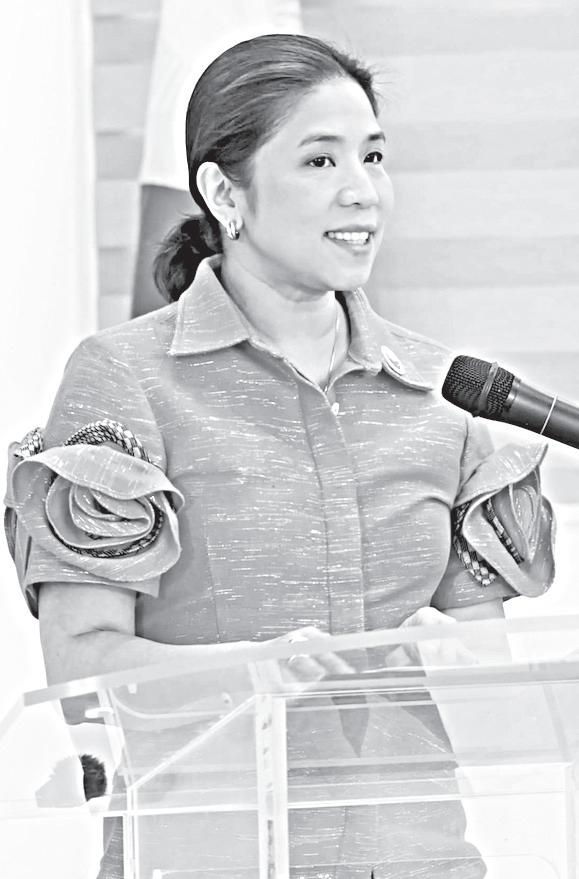
SECRETARY Amenah Pangandaman
includes support for UP Manila’s research programs and continuous operation of the Philippine General Hospital (PGH).
"Earlier this year, we likewise approved the creation of more than 1,000 additional positions
for UP PGH to augment its existing medical, allied medical, and support staff,” she said, then added that they aim to strengthen the hospital’s organization and manpower capacity to further provide quality healthcare services to its patients, especially indigent Filipinos.
In September, the Department of Budget and Management (DBM) chief reiterated the current administration’s commitment to increase funding for the education sector, and vowed to work closely with the Congress to ensure approval of increased allocations for SUCs.
“Education has always been our [top] priority under the NEP,” she emphasized in an official statement released earlier.
The ceremony honored 112 faculty and employees who served UPManila from 20 to over 40 years. Thirty-one retirees were also recognized for their invaluable contributions to the university.
AR EASTERN UNIVERSITY
F(FEU) and the Department of Environment and Natural Resources (DENR) formalized their collaboration on environmental protection and sustainability through a memorandum of agreement last October 17 at the DENR Forest Management Bureau in Quezon City.
The agreement reaffirms their commitment to promoting conservation, education, and civic responsibility. Through this partnership, FEU students, faculty, and personnel will continue to participate in reforestation, treetagging, coastal and upland cleanups, nursery management, and environmental awareness programs in coordination with the DENR Forest Management Bureau.
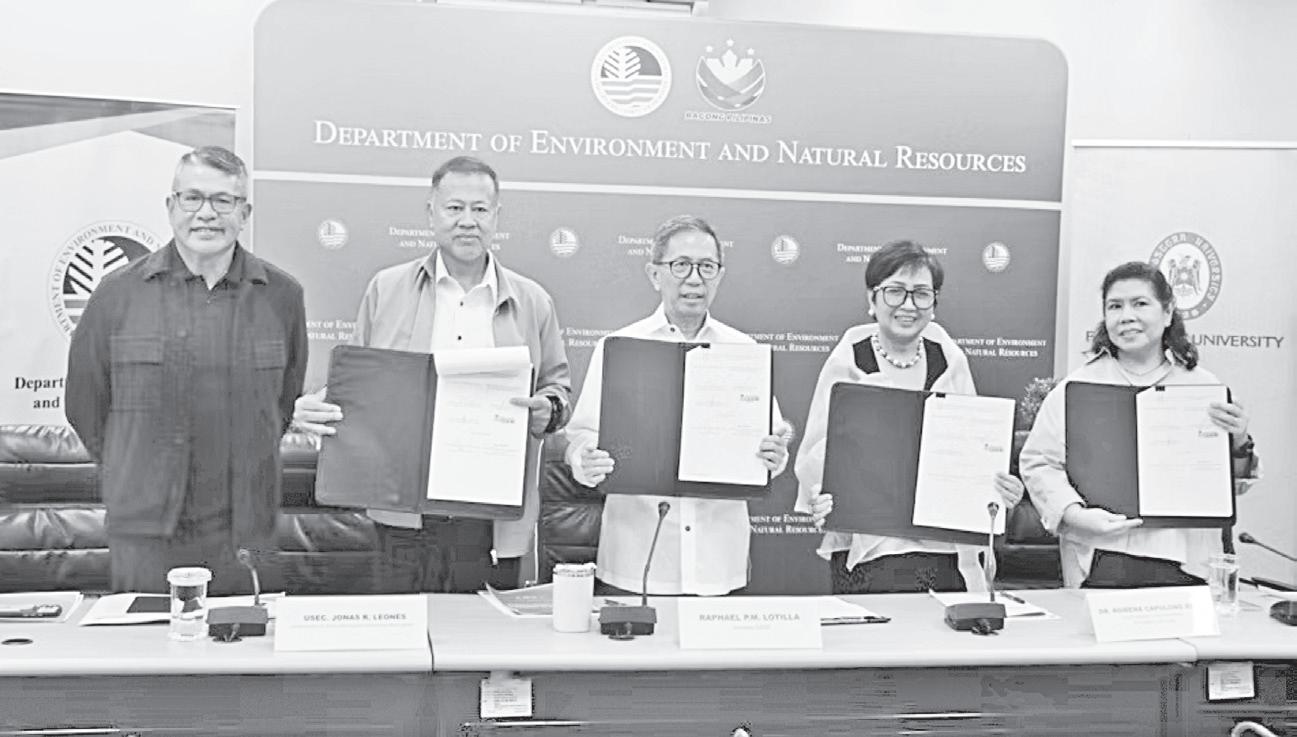
“This ceremony marks the continuing collaboration between the government and the academe, anchored in our shared vision of environmental protection, conservation, and civic engagement,” said DENR chief Raphael M. Lotilla. “Each tree planted, each coastline cleaned, and each student engaged contributes to a greener, cleaner, and more resilient Philippines.”
THE country’s leading culinary education institution Center for Culinary Arts (CCA Manila) held its inaugural “Tikim Weekend Food Market” last October 3 and 4 at the Brittany Hotel in Bonifacio Global City (BGC).
The event celebrated Filipino gastronomic artistry and innovation in action, while serving as a launchpad for aspiring food entrepreneurs and future chefs. More than a food fair, “Tikim…” was a dynamic learning and business platform where culinary passion met real-world opportunity through live discussions, mentorship from industry pioneers, and marketplace exposure for promising food brands.
For CCA Manila, the festival reinforced its 28-year mission to train world-class Filipino culinary talent through academics, experience, and entrepreneurship. Business workshops, real-world insights
THE two-day festival featured Tikim Business Workshops where participants learned from sea -
Editor: Mike Policarpio
UCHENGCO-LED Mapúa
YUniversity recently made a bold move in future-proofing their graduates to ensure their competitiveness in the workplace.
In a recent press briefing held in its Makati campus, School of Electrical, Electronics, and Computer Engineering (EECE) dean Dr. Arnold Paglinawan said the university decided to offer the first Bachelor of Science in Artificial Intelligence Engineering program in the Philippines toward creating “T-shaped graduates”—those who are broad or generalists across multiple disciplines, but have deep specialization in AI, which is seen as the natural evolution from Computer and Electronics Engineering.
Dr. Paglinawan said applicants will have to undergo an entrance examination, as with all engineering programs that they are familiar with: civil engineering, electronics engineering and computer engineering.
“It’s practically the same requirement for you to begin our AI engineering for five years, [such as] advanced manufacturing programs for those who are already working as engineers—particularly in the manufacturing industry,” he said.
office has been the university’s lead coordinator of its partnership with DENR, which began in 2024 and has since flourished through initiatives such as the Tamaraw Tree Hugging Campaign, Arbor Day Reforestation at La Mesa Watershed, and International Coastal Clean-Up.
Environment Undersecretary for Policy, Planning and International Affairs Atty. Jonas R. Leones and Undersecretary for Field Operations Joselin Marcus E. Fragada witnessed the signing.
To ensure all students gain essential skills, Mapúa’s Director for Operations, Technology, and Analytics Ericsson Dimaunhan said the university has embedded an institutional AI course into all its programs—including engineering and non-engineering courses like nursing. This means all students will study Generative AI and other critical topics to be familiar with the AI tools and skill sets needed in the modern industry.
Future-ready graduates
courses in Educational Technology to help teachers apply technology in teaching and learning.
Bitor added that for the university and the Rizal Commercial Banking Corp.—the banking unit of the Yuchengco group—AI, although a powerful tool, is not a replacement for human judgment and skill.
He said Mapúa’s approach to technology, particularly in grading, is heavily regulated by human oversight. While AI helps to grade an assessment based on a defined rubric, the final grade will still be the faculty member’s decision: “The faculty member’s domain knowledge is considered irreplaceable, and the university does not entrust giving a grade completely to an AI.”
Maximizing AI ACCORDING to Dr. Paglinawan, faculty members are trained in AI literacy across several dimensions, including critical thinking, attention, and human-centricity. This, he said, mandates that faculty must check and verify AIgenerated results and constantly judge the responses.
“This ensures they do not overrely on AI and maintain an ethical, human-centric approach to its use,” the dean said.
“We believe that education and environmental protection are inseparable partners in nationbuilding,” said FEU Vice President for Corporate Affairs Dr. Rowena Capulong-Reyes. “Through this partnership, our students, faculty, and personnel learn the values of stewardship, discipline, and civic responsibility that no classroom alone can teach.”
soned entrepreneurs and culinary leaders who have built successful ventures from scratch. Speakers included Cyrill Chan of Panero, who talked about scaling a bakery business, while Chef Menoy Gimenez explained menu engineering and profitability. Princess San Diego of What’s Your Flan? discussed passion-led concepts evolving into multi-franchise businesses.
CCA alumna Chef Danica Lucero of Say Halo! also inspired the audience, as she made waves when she impressed Chef Gordon Ramsay with her innovative rendition of the halo-halo during his visit to the Philippines.
Aaron Limpe-Aw of Destileria Limtuaco shared ways Filipino heritage flavors can succeed globally, while Chit Juan of ECHOStore highlighted sustainability and branding through local sourcing. Practical sessions on financial management, operations technology, and food safety rounded off the program.
“These workshops reflect CCA Manila’s long-established approach to culinary education that
Dr. Capulong-Reyes, Director of Community Relations Atty. Rosalie J. de la Cruz-Cada, along with FEU Controller and Chief Risk Officer Pamela Hernandez signed the agreement on behalf of FEU. The Community Relations
goes beyond recipe execution. Tikim became a learning space, as much as it is a celebration,” said Dr. Veritas F. Luna, Chancellor of CCA Manila. “By bringing together entrepreneurs, chefs, alumni, and foodies, we hope to highlight the hard work and creativity that go into building food businesses. This event reflects CCA’s vision of nurturing Filipino talent and shaping leaders in the culinary sector.”
Kitchen showcases, culinary storytelling ON Day 2, the program shifted to the Tikim Live Kitchen. There, guests witnessed culinary artistry in action through interactive demos by celebrated chefs and CCA Manila alumni, presenting food as both craft and storytelling.
Heritage dishes by Chef Reggie Aspiras and Chef Martin del Prado shone the spotlight on Filipino culinary roots, while Chef Sharwin Tee showcased global-meets-local innovation. Chef Anne Atanacio wowed the audience with her dessert innovation, inspiring creativity in modern pastry.
The agreement advances FEU’s ongoing environmental education and outreach programs that encourage responsible citizenship and leadership anchored on sustainability.
As this partnership continues to grow, FEU and the DENR Forest Management Bureau reaffirm their shared purpose to nurture not only trees, but also awareness, action, and hope for a cleaner and more sustainable Philippines, according to a statement from the university.
ASSOCIATE professor Dr. Marloun Sejera said the university is taking a bold step to integrate AI at both the foundational and specialized levels, ensuring their graduates are equipped for a future-ready workforce.
“Mapúa is actively developing programs for lifelong learners who need to upskill,” Dr. Sejera said. “This includes free online courses and specialized programs like Prompt Engineering and Advanced Manufacturing Programs focused on the application of AI in the manufacturing industry.”
Mapúa Malayan Colleges-Laguna’s Director of Artificial Intelligence Rolando V. Bitor noted that the university is also offering

Tikim Food Market ran on both days, which featured more than 30 curated food brands from alumni, emerging entrepreneurs, and established culinary names.
The diversity of merchants— from artisanal bakeries to modern Filipino café concepts—reflected the country’s fast-evolving food culture. The marketplace also served as a real-time business learning avenue for CCA students, who were encouraged to engage with vendors, observe best prac -
tices, and witness firsthand how culinary craftsmanship connects with consumer behavior.
Empowering next generation of chefs, entreps WITH campuses in BGC and University of the Philippines-Diliman, and accreditation from the American Culinary Federation Education Foundation, CCA Manila has long been recognized as the training ground for award-winning chefs and founders of glob -
Mapúa Malayan Digital Colleges’ Instructional System Design Director Noel Torregoza said the Yuchengco Group is leveraging AI for boosting productivity, transforming employee skillsets, and advancing education. For the group, Torregoza said the primary use of AI is to make work more efficient and focused for their employees, particularly in client-facing roles. In sales, AI is used to provide sales personnel with highly segmented and specific client information—a list of clients or a scan of the entire market—that they can use to their advantage. This reduces the time spent on generalized research, allowing the sales team to focus on direct client interaction.
In essence, the Yuchengco Group and Mapúa are working in tandem—the corporation ensuring its current employees are upskilled and made more productive through AI, and the university designing the educational infrastructure to produce the next generation of highly specialized and ethically grounded AI professionals. Rizal Raoul S. Reyes
ally recognized food businesses. “Tikim…’ is a direct extension of this mission—a living classroom where students gain exposure to entrepreneurship, innovation, branding, operations, and trend dynamics, beyond traditional kitchen practice,” explained Dr. Luna. “Many alumni leading ‘Tikim’ sessions, from global restaurateurs to micro-enterprise founders, began as CCA Manila students who transformed culinary passion into profession.”
The center’s alumni have earned global acclaim, leading hotel and cruise-ship kitchens and elevating Filipino cuisine worldwide. Dr. Luna remarked that “CCA Manila continues to be proud of its graduates’ diverse and successful career paths. They are garnering awards, leading kitchens of top hotels and cruise ships, and elevating Filipino cuisine to greater heights.” For information on student intake and programs, visit www.ccamanila.edu.ph, or email talktous@ cca-manila.edu.ph. Follow CCA Manila on Facebook and Instagram: @ccamanila.
www.businessmirror.com.ph
Saturday-Sunday, November 1-2,
By Leilanie Adriano
LAOAG CITY—The province of Ilocos Norte recently honored over 83,000 senior citizens for their legacy and contributions to nation-building, pledging to include them in various programs and activities organized by the local government.
As the culmination of the Elderly Week celebration, hundreds of senior citizens gathered at the Laoag City Centennial Arena for a day of entertainment that showcased their talents. The event featured the grand coronation of the 2025 Gwapong Lolo and Gandang Lola, complete with a royal court, escorts, and muses. In her short speech, Ilocos Norte Gov. Cecilia Araneta-Marcos paid tribute to her “dabarkads” for their presence and active participation during the Elderly Week celebration,
which has the theme “Embracing Age: Living a Life with Dignity and Purpose.”
“We have given so much of our lives for our children, for our communities, and for our province. Today, we come together to celebrate the lifelong contributions of our fellow elderly that continue to inspire the younger generations of Ilocanos,” she said.
Governor Araneta-Marcos assured the elderly that the provincial government will continue to uphold their welfare, dignity and participation in various programs and activities.
The Elderly Filipino Week is celebrated annually pursuant to Proclamation No. 470, signed on September 26, 1994 by President Fidel V. Ramos.
On top of receiving their monthly social pension, indigent senior citi-
By Delmar O. Cariño
LA
TRINIDAD, Ben -
guet—Five black pigs were offered to kabunyan (supreme deity) on Saturday as this capital town celebrates Indigenous Peoples Month, but a “mambunong” (native priest) in leather boots became the unexpected focus of attention during the traditional rites.
Mambunong Peter Aguilba, 68, led the ceremony, chanting in the vernacular to seek blessings and protection from the heavens and the ancestors for the town’s indigenous communities.
The Ibaloi and Kankanaey tribes dominate this Benguet town.

As the pigs were slaughtered, with sharpened wooden sticks called owik thrust directly into their hearts, Aguilba called on those who heard the squeals to join the day-long kanyaw (feast) and dance the tayao (traditional dance) to the rhythm of gongs.
“The louder the squeal, the better, so the gods can hear the people’s clamor for peace and progress,” he said.
Beneath the celebration, however, there is a concern.
Richard Wacnisen, the Indigenous Peoples Mandatory Representative (IPMR) to the Sangguniang Bayan (municipal council) of this capital town, said in an interview that the practice of having a mambunong must continue as indigenous cultural communities still perform rituals based on timetested customs.
Vanishing breed
“ THEY are a vanishing breed and we are at a loss on how many are still there,” he said. “Our tribes must educate and train future native priests because our cultural practices are here to stay.”
Wacnisen, a kankanaey, expressed fear that the decreasing number of traditional priests would leave unattended those clans and families who want their sick to be prayed over by the mambunong or to lead a thanksgiving ceremony following a bountiful harvest.
Even Aguilba, a farmer from Ambiong and considered the most sought-after mambunong, cannot estimate their number. He said that no formal schooling is required for one to become a mambunong.
“As one grows old, he needs to know the customs and traditions of his tribe, get immersed in the beliefs and practices, and be present during rituals to better appreciate one’s craft,” he explained. “There are no ceremonies to bestow the honor.”
Valdred Olsim, municipal tourism officer, said his office will soon undertake research on the status of the town’s native priests and find out how many of them are still alive.
Mayor Roderick Awingan acknowledged that it is timely to create an inventory of the town’s remaining traditional priests to document and support them.
“We have programs for senior citizens and centenarians. It is high time we give particular attention to our rare breed of native priests,” he said.
Awingan said he himself could not do away with the help of the mambunong.
Before he filed his candidacy for mayor in the May 2025 elections, he said he had to seek blessings from the gods and got the services of a native priest.
“We butchered and offered a native chicken at that time,” he recalled.
The expertise AGUILBA demonstrated what a tested mambunong could do.
After the pigs were opened, he examined their livers and bile sacs, interpreting them to determine if any of them presented a bad omen.
“The livers were nicely spread with less bile and blood. This means the occasion can proceed as it will bring progress to all,” he said.
He stated that there’s no science at play, just wisdom gained from years of experience. He can’t remember how many rituals he has conducted or how many pigs he has witnessed being slaughtered.
He noted that a mambunong must never accept money for prayers, calling it taboo that would destroy the sacredness of the tradition.
As for his leather boots, he
and said he simply feels comfortable
them.
zens in the province continue to receive medical and burial assistance from the provincial government through Provincial Ordinance No. 2018-10-063.
Through this ordinance, a qualified beneficiary is entitled to a minimum of P5,000 in the event of death and P3,000 for medical expenses.
The province is also open to hiring interested senior citizens as museum guides in government-managed museums to share their expertise in history and culture.
Through the National Commission of Senior Citizens, various service caravans are offered to the elderly. These include medical consultations, vaccinations, wellness activities, livelihood assistance, legal counseling, recreational opportunities, and disaster preparedness training, among others. PNA

The ‘Jack n Poy’ philosophy of life
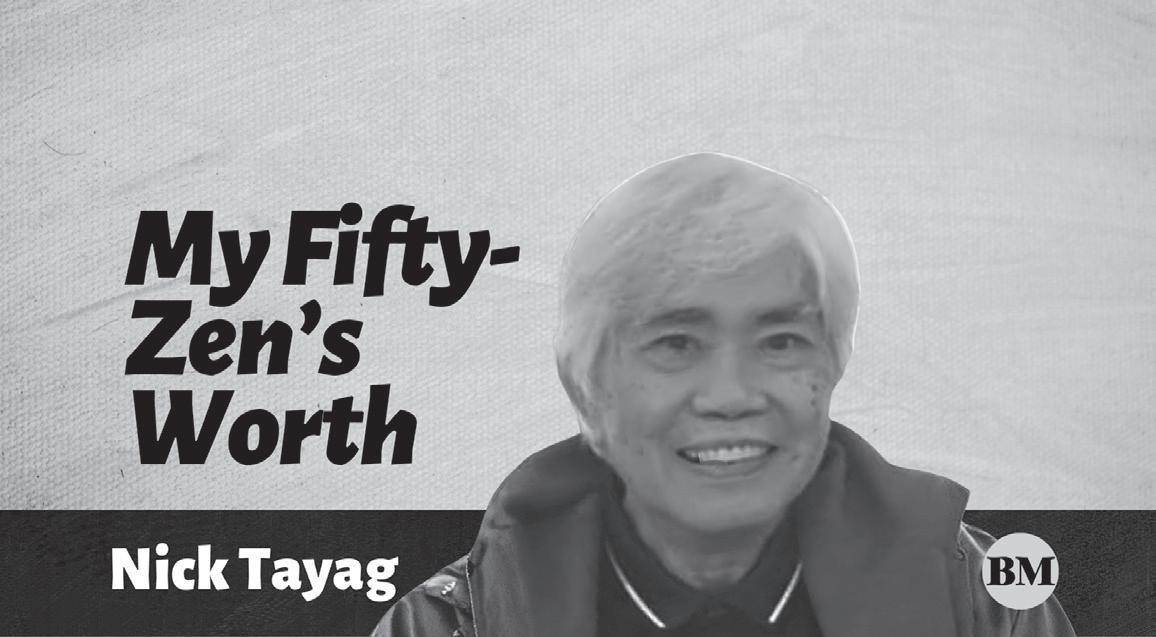
JACK en poy, oli oli hoy! It was only when I was already an adult that I discovered that the closed fist game I used to play since childhood originally came from Japan.
The one who enlightened me was a young Japanese government bureaucrat from JICA (Japan International Cooperation Agency) who was sent here to oversee a Japanese government assisted project.
We were having a drinking bout and I wanted to pay for our beers as a gesture of native hospitality but he insisted on footing the bill since he had consumed more. Finally, to settle the matter, he suggested we play “Janken Pon,” which I assumed he meant “Jack n Poy,” the “rock-paperscissors” closed fist hand game I grew up playing in the province. Coming from him completely surprised me because up to that point, I mistakenly thought it was a Filipino native game.
After settling the matter of who would foot the bill through “Janken pon” (he won), the JICA fellow then enlightened me that the “rock-paper-scissors” game was not only as Japanese as “ramen” or “sushi,” but it was in fact an entrenched, organic part of the culture of Japan. It’s their version of the Western “toss coin,” employed to resolve all kinds of disputes, disagreements and uncomfortable situations by way of the game’s simple mechanics.
pan often hold promotions that challenge guests to play a match with waiters and waitresses for a free drink or a discount. I’ve even seen a Japanese yakuza film with a “janken pon” match played like a Russian roulette to settle a life-or-death stand-off.
“Jack n Poy” may seem just a child’s play but in my lightbulb moments (“santori” as Zen monks would call it) I slowly began to see it as a good philosophical approach to life for mature adults.
I’ve always been a simple man and I prefer a guiding philosophy that is simple, lighthearted, and natural. I get my inspiration and learnings from the most unlikely things and places.
“Jack n Poy” is beautiful and
moments when what you get for your efforts is as thin as paper or the paper document you’ve signed places you in a more difficult situation. Yet a piece of paper can turn out to be life-saving.
The key is to leave yourself open to whatever comes. Embrace all that life gives you –the good with the bad, the joyful with the painful. Keep in mind the truisms: be strong as a rock, unshaken by the storms of life; they may wear you down but will never break you. Nothing is really lost or wasted. You always end up better, stronger.
With this philosophical mindset in mind, I now treasure three objects as my most cherished possessions. A collection of 5 stones, recycled paper, and a pair of slightly rusty, old scissors. Bato, papel, gunting.
ity yet achieved glory, beauty, truth, knowledge, virtue, and abiding love,” wrote George Bernard Shaw. By enabling me to assemble words, paper enables me to continue the process of self-discovery and affirmation. For without self-reflection and critical thinking, my life is without purpose and meaning.

The stones remind me of the hard trials I’ve faced and endured through the years and made me what I am now.

brilliant in its simplicity: Two players. Three possible moves. One ultimate outcome. So, when you think about it, it can be an ideal playbook for the game of life.
Later on, when I got the chance to visit Japan, I was able to confirm that my JICA friend was right.
“Janken pon” is a common drinking game among Japanese friends and office workers. Restaurants and bars all over Ja-
Just like with “Jack n Poy” you never know what life will give you at every turn. Sometimes you win, sometimes you lose. Sometimes your luck turns out to be as hard or heavy as a rock, replete with difficulties, challenges, hard choices. At times you encounter experiences that cut your heart into pieces the way a pair of scissors cuts a piece of paper or fabric. Then there are
Keeping an old pair of scissors as a favorite possession teaches me to cut the chords that get me in trouble, such as attachments, old habits, toxic friends and other messy aspects of my life. At the same time, they teach me to be creative like a child in kindergarten cutting various shapes out of colored paper. As someone said, “In every snip, possibility unfolds.” They also remind me to be mindful of my attitude and words. Making cutting remarks, bad mouthing others can wound others, the way a pair of scissors can. Remember the adage: “Don’t run with scissors”?
The stacks of recycled paper on my desk serve as empty vessels into which I pour my thoughts on everything around me. “Paper has more patience than people,” wrote Anne Frank. She had nowhere to go and nothing to do except to stay in her hiding place and write about her feelings and experiences. “Only on paper has human -
Yet even as I put words on paper, I also grieve for the trees that have given their lives for the sake of human convenience. This is why I value every piece of paper. I am adopting a more eco-conscious approach to everyday life.
So, as I go on through each day of my twilight years, I play “Jack n Poy” at every turn. If, paper beats rock, I wrap up those hard feelings with thoughtful reflection, sifting through the rocks for a golden nugget of insight. But even rock can be transformed with a sharp pointed tool into something beautiful and enduring. Consider the statue of David and Pieta by Michelangelo.
Just as a rock remains invulnerable to scissors, regardless of their sharpness, I strive to blunt the cutting remarks, barbs and insults of other people with the confident belief that I am a rock, with a strong and resilient core. After everything is said and done, this “Jack n Poy” philosophy of life will not replace the awesome wisdom of Lao Tzu, Confucius, Socrates, Plato, Aristotle, Sartre and other sages.
With “Jack n Poy” as a perspective, I now approach the years I still have to live with a lighthearted sense of acceptance. As a dual-purpose tool, it serves as my do-it-yourself GPS to guide me in navigating life’s surprises and complexities, as well as my Swiss knife to help me extract enriching lessons from whatever life will be throwing at me in the final stage of my journey.
A14
November 1-2, 2025

Where Fire Met Sea
THERE are places on Earth where time stands still—where water becomes the keeper of stories and the sea hums with memory. Off the coast of Catarman, Camiguin, lies one such site—the Sunken Cemetery, marked by a towering white cross that rises solemnly from the ocean. Beneath it rests an entire town swallowed by the sea.
As a seasoned diver, mermaid instructor, and travel journalist, I’ve explored countless coral walls and shipwrecks across Southeast Asia. But the first time I descended into Camiguin’s fabled depths, I knew this wouldn’t be just another dive—it would be a communion with history.
The Isle Born of Fire CAMIGUIN’S story is one of fire, faith, and rebirth. Known as the “Isle Born of Fire,” this small emerald gem in Northern Mindanao was forged by seven volcanoes, each shaping the island’s fate through centuries of eruptions.
The most cataclysmic event came in 1871, when Mount Vulcan violently erupted, burying the old town of Catarman under ash and lava. Homes vanished, the church crumbled, and the town cemetery sank as the earth gave way to the sea.
Today, a giant cross marks the resting place of generations—a poignant symbol of loss and renewal. Standing there before my dive, watching the sun cast its glow over the marker, I couldn’t help but feel the pulse of both tragedy and transcendence.
Descent into Memory WE entered the water just as the midday sun shimmered over the
Bohol Sea. The surface was calm, glassy—a mirror to the mountains that once roared fire. I adjusted my mask, checked my air, and began my descent into silence. The slope beneath the cross revealed a world of quiet transformation. Coral heads, sponges, and anemones had claimed what was once sacred ground. Fish darted between coral-encrusted stones— sergeant majors, butterflyfish, parrotfish, and angelfish turning the once-somber landscape into a vivid mosaic of life.
A blue-spotted stingray drifted across the sand, while a lionfish hovered like a ghost near an old coral mound. Peeking through crevices, I found moray eels and a playful pufferfish, reminders that nature never truly surrenders—it simply adapts. At around 20 feet, my dive light brushed what locals believe are remnants of the old gravestones. Coral had softened their edges, sea fans wrapped them in living lace. It wasn’t eerie—it was peaceful, as though the ocean had become a cathedral.
“I didn’t just dive into the sea—I dove into Camiguin’s soul.”
Surfacing, I traded my scuba tank for my mermaid tail—a shimmering turquoise fin that flowed like light through water. Free-diving above the cross, I felt suspended between worlds. Down below lay a story of death and rebirth; above, the sun—radiant and forgiving.
Legends Born of Fire
CAMIGUIN’S origin stories are as dramatic as its landscape. One legend speaks of Magbangal, a demigod farmer who angered the spirits by tilling forbidden land. In wrath, the earth







erupted, engulfing his fields — giving birth to the island itself.
Another myth claims that Camiguin was once part of mainland Mindanao, until a jealous sea spirit tore it away, surrounding it with fire and waves.
Whether divine punishment or natural wonder, these tales mirror what science tells us—that this island was born from volcanic upheaval, and that life here has always been shaped by the dance between destruction and renewal.
Life Among the Tombs
THE Sunken Cemetery today is one of the most accessible dive sites in Camiguin, welcoming both divers and


snorkelers. The upper reef, only 5–10 meters deep, bursts with color — perfect for those who prefer to stay near the surface.
Marine life thrives here: clownfish, wrasses, nudibranchs, pipefish, batfish, and juvenile barracudas weave through coral gardens that have made this sacred ground a sanctuary. Occasionally, hawksbill turtles glide through, and if you’re lucky, you’ll spot reef squid or garden eels peeking from their sandy burrows.
The reef’s transformation from cemetery to living memorial is what makes it magical. It’s a reminder that even in loss, nature finds a way to bloom again.
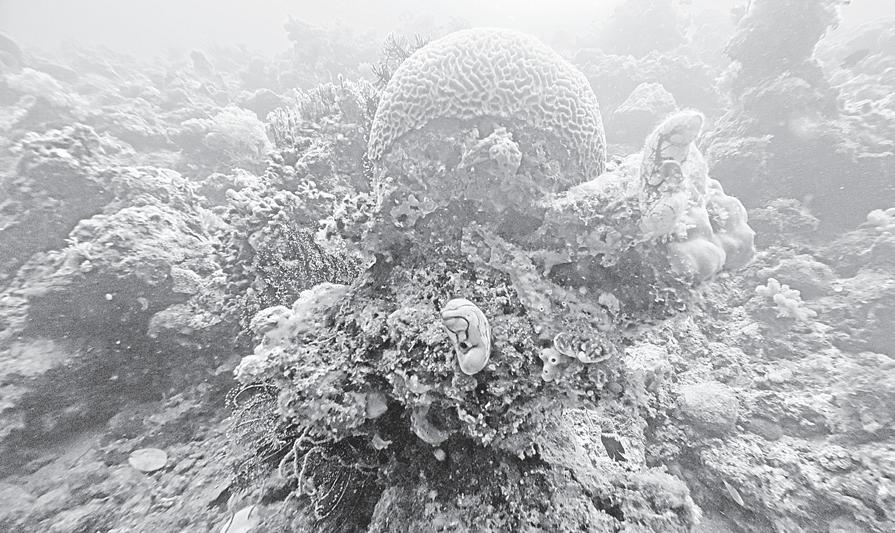

Top 10 Dive Spots in Camiguin
1. Sunken Cemetery / Old Volcano Site— Coral gardens and history intertwined.
2. Burias Shoal— Strong currents, massive coral heads, and pelagic visitors.
3. Mantigue Island Sanctuary —Protected reef teeming with turtles and reef sharks.
4. White Island Reef —Colorful, shallow dive with postcard-perfect visibility.
5. Katibawasan Drift —Fastpaced dive for the adventurous, with schooling jacks.
6. Tangub Hot Spring Reef —A rare blend of warm volcanic and cool ocean currents.
7. Black Forest (Hibok-Hibok) Volcanic sands rich in soft corals and sponges.
8. Jigdup Reef —A macro lover’s dream: frogfish, nudibranchs, and leaf scorpionfish.
9. Old Catarman Church Wreck —Coral-covered ruins with mysterious silhouettes.
10. Tuasan Reef— Gentle slopes and vibrant coral gardens, ideal for beginners.
Every dive here feels personal — as though the sea itself is inviting you to rediscover its ever-changing beauty.
IGAUCU FALLS In awe of nature’s beauty
& photos
Story
by Joshua Berida
SEEING the Iguacu Falls in person was only a pipe dream when I started traveling outside the Philippines several years ago. As the years went by, thought that seeing the famous waterfall was out of my reach. However, after years of working, was finally able to set foot in Brazil. Visiting the country was a dream come true more so because was also able to see Iguacu Falls in person. I booked a flight from Sao Paulo to Foz do Iguacu. The latter serves as the jump-off point for the national park.
The Mighty Iguacu THE massive park is easily accessible from the city. I took the bus to the park and bought my ticket on the same day. I admired how the local authorities built the tourism infrastructure of the park. My impression was that it wasn’t intrusive to nature and that it made the waterfalls accessible to everyone of all ages. The varied and thriving flora and fauna of the park also make it a point of interest and preservation of zoologists and botanists. There are walking platforms, stairs, and rails. You can also find food stalls and shops during your visit. Park buses can take you to different areas if you want to ride a boat, trek or go biking. took the easy walking trail that provided the best views.
Fast facts about Iguacu Falls:
n The Brazilian side of the park received a UNESCO World Heritage Site designation in 1986.
n Its name means “great water” in Guaraní.
n It’s wider than Niagara Falls.
n The Brazilian government established Iguacu National Park in 1939.
n Argentina established its own Iguazu National Park in 1934.
The first section of the falls blew me away already. The multiple cascades, cataracts, and tiers were impressive. I could see boats making their way under the cataracts. It must’ve been an exhilarating experience for those park goers. I navigated my way through the platforms to get different angles of the waterfalls. The most famous and photographed section of the park is Garganta do Diabo or Devil’s Throat. Despite the developed state of the park, I felt a sense of adventure upon seeing Iguacu’s different sections. It might have been the same sense of wonder and adventure that Álvar Núñez Cabeza de Vaca felt when he became the first Spanish explorer to visit the waterfalls in the 1540s. A short walk and multiple stops for photos led me to the main attraction of the park, Devil’s Throat. I received multiple text messages about entering Argentina from here. Visitors can view this section of the park from either the Brazilian or Argentinian side. I was in awe of what I saw as I went through the large groups of people waiting for their turn to stand near the railings of the platform.
The powerful cataracts sprayed droplets of water, making it feel like it was raining. The mist that the cataracts created at the foot of the drop to the canyon added to the waterfall’s allure. There’s still nothing like the beauty of nature. I concluded my trip a bit wet, but full of fond memories.
At the Crossroads AFTER half a day of visiting Iguacu National Park,
because visitors can see three different countries such as Argentina, Brazil, and Paraguay. This landmark is also the meeting point of two rivers, the Parana and Iguacu. The beautiful landscape draws thousands of visitors after their trip to Iguacu National Park. This attraction caters to tourists. It has shops, food stalls, and cultural performances that tell the intertwining histories of the three countries. There’s a light show if you decide to stay until late in the evening. Iguacu Falls is a noteworthy addition to any bucket list. I was ecstatic to have finally ticked it off my list despite the multiple layovers and hours long flights. wish I had more time to spend in the park and do other activities such as boating. However, this missed opportunity gives me more reasons to return. The park was part of a much longer trip around Brazil.
Editor: Jun Lomibao

Lumbo frustrates Bautista in 5-hole playoff in Davao
JEFFREY LUMBO seized the moment Russell Bautista lost his rhythm—calmly drilling a nervewracking birdie putt from 16 feet on the fifth playoff hole—to run away with the International Container Terminal Services Inc. South Pacific Classic crown in Davao on Friday.
As the ball disappeared into the cup, the thunderous roar from the packed gallery echoed Lumbo’s triumphant ascent, while Bautista’s putt from six feet agonizingly veered left, sealing his heartbreak and handing Lumbo the title.
The showdown unfolded like a cinematic masterpiece—a highstakes duel between two determined players desperate for their career breakthrough.
Their five-hole playoff battle was a grueling test of skill and nerves, and it etched itself as the second longest playoff after Rene Menor nipped Thailand’s Pasavee Lertvilai on the sixth playoff hole in the 2017 Philippine Golf Tour Asia at Splendido Taal.
It also eclipsed Justin Quiban’s four-hole playoff victory over Marvin Dumandan, which also took place at the same South Pacific layout in 2023.
“I didn’t expect to make a comeback. I just enjoyed my game—I didn’t think about how big the opponent’s lead was or how many holes were left,” Lumbo said. “In the playoff, I didn’t let the pressure get to me. I just stayed focused and enjoyed it.”
Bautista by four shots after 54 holes and even by five midway through the final round but didn’t flinch while Bautista posted an impressive 32 on the front nine.
Lumbo matched it with a bogey-free 33, quietly staying in the hunt, when the momentum shifted.
Bautista began to falter under the immense pressure, bogeying holes 11 and 16, while Lumbo surged ahead, sinking a clutch pitch-in birdie on No. 14. By the time they reached the parfive 18th, Bautista still clung to a twoshot lead, but the Saranggani pride, who also calls the South Pacific home, was undeterred and holed a stunning 12-foot birdie putt, finishing with a 67 to force sudden death at 10-under 278. Bautista’s par putt from six feet wobbled and swerved left at the last moment, resulting in a costly bogey and a 72. In the playoff, the tension mounted with every shot and both players answered each other’s challenge through the first four holes—all on the par-four No. 9.
By Aldrin Quinto
SAKHIR, Bahrain—Just before the curtains fell on the action at Exhibition World Bahrain, the Philippine national anthem echoed triumphantly once more in the Asian Youth Games.
Isabella Joseline Butler stood on top of the podium, a fitting coronation after reigning supreme in the girls’ -63 kgs class of jiujitsu on Thursday.
In dominant position from the getgo, the 17-year-old Butler submitted the United Arab Emirates’ Aysha Aljneibi by collar choke with one minute and five seconds left in the bout, to the delight of the Filipino crowd. Born in Davao City, Butler moved to the United States at age seven and is glad to be back to her roots and deliver for the Philippines.
Butler’s victory raised the Philippine haul to seven gold, seven silver and 10 bronze medals—securing 12th place in the 45-nation meet.
Kram Airam Carpio bagged the Philippines’ first gold medal, winning the pencak silat girls’ 51-55kg, while also delivering gold for the national team were Charlie Ratcliff in modern MMA (girls’ 45kg), Pi Durden Wangkay in athletics (boys’ 200 m), Lyre Anie Ngina (muay, girls’ wai kru 14-15), Zeth Gabriel Bueno (muay, boys’ wai kru 14-15), and the pair of Jan Brix Ramiscal & Tyron Jamborillo (muay, mixed team mai muay).
“We found that there was a way to represent the Philippines through the sport that I love doing. And so thankfully I was able to represent the Philippines and so now we’re here.”
Butler, who clinched gold in her first stint for the Philippines at the JJIF Jiujitsu World Championships in Greece last year, is now setting her sights on a bigger stage.
“I’m running to try out for the adult team next year and compete at the SEA [Southeast Asian] Games.”
In the AYG, Butler’s technical mastery was on full display.
She overpowered Uzbekistan’s Ziyoda Shomurodova, 4-0, in the semifinals after waylaying Thailand’s Maria Elissavet Kokoliou, also 4-0, in the quarterfinals. In the Round of 16, the lass from Davao submitted Kazakhstan’s Ayaulym Dossymzhankyzy with clinical precision.
“I was able to get to my controlling positions at close guard, which I love, and I was able to work from there,” Butler said.
“All of the stuff that I’ve been doing in training, working on close guard and attacks from there as well as my lapel guard-which I was able to display today, that was really cool,” Butler said.
Butler also lauded Aljneibi for a solid performance in the final.
“I think her style was really good, she had a really strong base, she was able to also keep the positions strong but I feel like I was able to push the pace more and
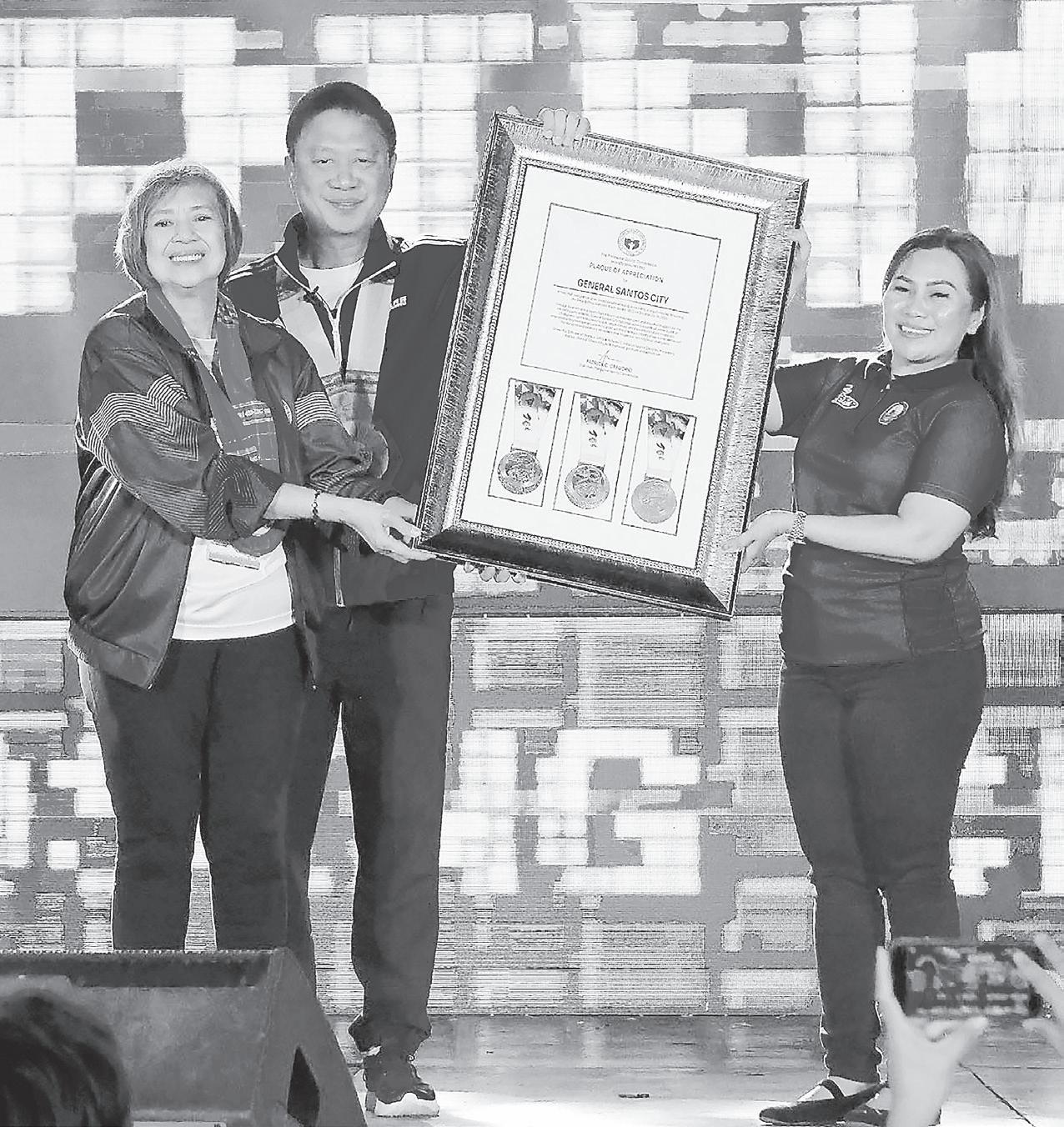

get into the positions that I wanted to so I was able to get the advantage in the fight.”
Meanwhile, Mara Alexandria Sarinas added to the Philippine medal tally, bagging bronze in the girls’ -57kg division with a win by submission over Thailand’s Prasita Rumakom.
The 15-year-old Sarinas also triumphed in the repechage against Tajikistan’s Fariza Qosimboeva, 4-0. She earlier lost in the quarterfinals to South Korea’s Choe Seulbi, 0-6, after submitting Thailand’s Tanaya Pornsakpraset in the Round of 16. Seulbi went on to win gold, beating Kazakhstan’s Amina Zhumabekova, 8-0.
Butler said she relished the camaraderie and scale of the event.
“It’s incredible, I love it so much. I worked so hard, too, so I’m so thankful I’m able to be here and represent the Philippines,” she said.
Though she doesn’t speak Tagalog, Butler shared she can speak Bisaya— “Enough to get bay,” she said with a laugh. Sebastien Blaize Cabanlig fell short of the podium as Vietnam’s Hoang Manh Luong won by advantages in the bronze medal match of the boys’ -48kg class. Cabanlig was earlier stopped in the semifinals by Tajikistan’s Mustafo Qudridinov via submission.
“Don’t
said O’Neil said in a statement shortly after the recent 53rd FIG Artistic Gymnastics World Championships held in Jakarta.
“We saw this with last year’s Paris Olympic Games and at the recent world championships. Two years is a relatively
time for gymnastics,” said the veteran British FIG Media chief of the third edition of the world junior meet set November 20 to 24 at Manila Marriott Hotel Grand Ballroom inside the Newport World Resorts in Pasay City. The Philippine hosting is organized by the Gymnastics Association of the
Philippines and supported by the Office of the President and the Philippine Sports Commission.
The last two editions held initially in Gyor in Hungary in 2019 and the second staged in Antalya in Turkey two years ago were the spawning grounds of the youthful junior gymnasts to flourish on the global gymnastics stage.
A sterling example is Japanese Paris Olympic men’s individual all-around gold medalist Shinnosuke Oka, who ruled the event in the inaugural world juniors at the 5,500-seat Audi Arena in Hungarian city 121 kilometers northwest of the capital of Budapest. On the other hand, the world junior meet held at the Antalya Gymnastics Hall in the bustling seaport Turkish city two years ago produced gymnasts who figured prominently in the last world championships held in Jakarta. Among them were Italian Tommaso Brugnami and Japanese Tomaharu Tsunogai, who were the vault and horizontal bar gold medalists at the world junior meet in 2023.


EIGHT days of surfing on Siargao Island off Cloud and it all comes down to Indonesian Bronson Meydi and Australian Ziggy Aloha Mackenzie lifting the biggest prizes and the precious ranking points in the World Surf League (WSL) QS6000 in General Luna town.
“I can’t believe it…wow! That was a crazy final,” said Meydi, only 20 and last year’s WSL world junior champion. “The waves went slow and just in my favor, so it was lucky. So lucky that the big one came and stoked to get an 8.8 on that one.”
Meydi scored a remarkable 15.33 total score after four waves in the final round Thursday to grab the top of the podium over Australia’s Ben Loretson, who ranked second with 14.70 after seven waves. Mackenzie, on the other hand, made 12.73 points to bring down


fellow Aussie Isla Huppatz’s 11.60 points after 11 waves for a total of 19 waves in the women’s competition of the event supported by the Philippines Sports Commission (PSC).
Only 16, MacKenzie averaged 11.09 in heat scores and 3.43 in wave scores through the round of 48 where she was never been intimidated by the competition despite her young age .
“I came into this event trying to look at it in a fun way and just enjoy surfing Cloud 9 with no one else out and I’m so shocked and happy and stoked right now,” Mackenzie said.
“Isla [Huppatz] is one of my best mates and she absolutely ripped so I knew I had to bring my best surfing,” she said.
“It was a bit shaky there at the start, but I am glad I ended up getting that little barrel, and yeah, going into the lead.” Another Aussie and one of the favorites to dominate, Dane Henry, was remarkable run with 17.7 points in the Round of 16 where he led but Meydi couldn’t be denied in their quarterfinals with 16.17 points against Henry’s 15.03 in 18 waves to reach the semifinals. Meydi beat another Aussie Harley Walters with 16.57 score over 13.40 in total of 17 waves for the final ticket while Loretson defeated fellow Australian Tom Whitpaine with 16.50 score over 12.13 to
TBy Josef Ramos
HE Association of Boxing Alliances in the Philippines (ABAP) won’t heed to the International Boxing Association’s (IBA) appointment of professional boxing Hall of Famer Manny Pacquiao as its vice president.
The IBA has been outlawed in June 2023 by the International Olympic Committee (IOC) for flagrant biased officiating in major international competitions and the IOC recognized World Boxing (WB) as the sport’s international federation.
ABAP president Ricky Vargas is a founding director of WB, which was established in April 2023 to combat IBA and now has 125 national federation members.
“We cannot participate because of our strong ties with World Boxing and the IOC,” ABAP secretary-general Marcus Jarwin Manolo told BusinessMirror on Friday. “National federations with World Boxing, as well as boxers, referees, coaches and officials are barred from joining any IBA related matters.” Pacquiao expressed positive
and Vice Mayor Romina RusillonSajulga and Surigao Del Norte Governor Robert Lyndon Barbers.
remarks about his IBA appointment which he described as a “new friendship” because of IBA’s desire to establish a new level of grassroots boxing worldwide.
“We collaborated some ideas, we mixed it up and we’re going to set up the Manny Pacquiao Boxing Academy all over the world so we can help all aspiring boxers to achieve their dreams,” Pacquiao told reporters during the “Thrilla in Manila” 50th anniversary fights at the Smart Araneta Coliseum on Wednesday night. “The result is beautiful and we can do a lot of things with this new friendship with IBA,” Pacquiao said. “We can help a lot of boxers


Halloween pumpkin waste is a methane problem, but chefs and farmers have solutions
SATURDAY-SUNDAY, NOV. 1-2, 2025 | soundstrip.businessmirror@gmail.com
Story and photos by Zoe Davad
The beauty of music is in the ear of the beholder. Words alone can’t do justice to the audible gasps of recognition that filled the hall when the Philippine Philharmonic Orchestra (PPO) began its first notes — a fast-paced, lively mix of soundtracks from popular K-dramas such as The World of the Married and Mr. Sunshine.
As the music swelled, so did the audience’s emotions. Under the baton of Maestro Herminigildo G. Ranera, each crescendo summoned collective memories of heartbreak, doomed love, and quiet redemption; the stories replayed countless times on screens big and small. On a rainy October evening, the Samsung Hall in SM Aura, BGC saw its audience transported into the cinematic multiverse. The event, OST Symphony II: K-Drama in Concert, was a collaboration among the National Commission

Publisher :
Editor-In-Chief : Concept :
Y2Z Editor :
T. Anthony C. Cabangon
Lourdes M. Fernandez
Aldwin M. Tolosa
Jt Nisay
SoundStrip Editor : Group Creative Director : Graphic Designers :
Edwin P. Sallan
Eduardo A. Davad
Niggel Figueroa Chow Jarlego
Contributing Writers :
Tony M. Maghirang
Rick Olivares
Jingo Zapata
Reine Juvierre S. Alberto
John Eiron R. Francisco
Ica Hontiveros-Cheng
Ana Zoe V. Davad
Justine Xyrah Garcia
Ginger Franz S. Ocampo
Trixzy Leigh Bonotan
Bless Aubrey Ogerio
Photographers :
Bernard P. Testa Nonie Reyes
Y2Z & SOUNDSTRIP are published and distributed free every Sunday by the Philippine Business Daily Mirror Publishing Inc. as a project of the
The Philippine Business Mirror Publishing, Inc., with offices on the 3rd Floor of Dominga Building III 2113 Chino Roces Avenue corner Dela Rosa Street, Makati City, Philippines. Tel. Nos. (Editorial) 817-9467; 813-0725. Fax line: 813-7025
Advertising Sales: 893-2019; 817-1351,817-2807. Circulation: 893-1662; 814-0134 to 36. www.businessmirror.com.ph
for Culture and the Arts, the Korean Cultural Center in the Philippines, and the Cultural Center of the Philippines. More than a partnership between institutions, though, it stands as proof of the cultural connection and mutual love of storytelling that unites South Koreans and Filipinos.
This was not the typical orchestra crowd where reverent silence reigns. It was a gathering of fans who had loved, wept, and dreamed alongside fictional characters for years, who did not hesitate to cheer when their favorites came on and clap after every song.
And because admission was free, the audience represented a rare democratic crosssection — students, parents, office workers, younger children — who might not ordinarily attend a concert but came for pure love of the stories that loved them back. The PPO’s performance allowed ordinary Filipinos to inhabit the sonic grandeur often reserved for concert halls, while still connecting through something as personal and relatable as K-drama soundtracks.
Familiar melodies feel both elevated and deeply personal. It was as if the concert was saying these stories also belong in the halls of art.
Though one might question why the K-drama strikes such a deep chord with many Filipinos, one only has to examine our shared emotional DNA. Filipinos are romantics at heart – dramatic, expressive. We are endlessly drawn to grand gestures, bittersweet endings, and narratives of love persisting against all odds.
Korean dramas speak to this sensibility, not hesitating to mirror the Filipino taste for intensity and melodrama with equally shameless sentimentality. Their soundtracks give those emotions permanence. In a culture where music underscores daily life, from karaoke nights to heartbreak playlists, it’s no surprise that Filipinos have embraced K-drama OSTs as part of their own emotional language.
When the first clear strains of “My Destiny” from the Filipino adaptation of My Love from the Star echoed through the hall, sung by actress and singer Kyline Alcantara, it was pure nostalgia. Alcantara introduced the song by reflecting that “K-dramas have found beloved homes in the hearts of Filipinos.”
Actress Angel Guardian performed the theme song “Bagong Tadhana” from Encantadia



Chronicles: Sang’gre, a homegrown fantaserye inspired by Filipino mythology. Despite recovering from illness, Guardian delivered a performance as heavenly as her name. “Para sa iba, isa lang itong awit,” she later wrote on Instagram, “pero para sa akin, ito ay bunga ng ilang linggo ng pagsisikap.”
Her determination, like the heroines she sang of, became part of the night’s story.
One medley later, singer-songwriter Isaac Hong made his entrance. His “Fallin’” from Queen of Tears became one of 2024’s most-streamed OSTs. His vocals filled the hall, moving seamlessly into “In You”, his original composition, and “My Love By My Side” from When Life Gives You Tangerines.
Between songs, Hong candidly admitted, “The Philippines was my first foreign country — I came here when I was in fourth grade. I never dreamed I’d be standing here again, singing for you guys.”
One medley later, Korean vocalist Yegny took the stage and easily commanded it with her resonant, powerful vocals. She performed iconic tracks such as “Starry Pieces” from You Are the Apple of My Eye, “Golden” from K-Pop Demon Hunters, and “Diamond” from Itaewon Class. Clad in sleek black, she performed with the poise of a diva and the warmth of a storyteller. Her rendition of “Beautiful Life” from Goblin silenced the hall; her crystalline tone captured both the
ache and hope of eternal love.
As the concert neared its close, the audience erupted into chants for an encore. The organizers hadn’t planned for one, but the applause was relentless — the kind born not of politeness but of passion. The orchestra obliged, returning to play the Goblin OST and a symphonic reprise of “My Destiny.”
At its core, OST Symphony II wasn’t just about the music of Korean dramas. It was about what those dramas mean to Filipino audiences. K-dramas have become cultural companions — mirrors that reflect our own romanticism, our yearning for poetic justice, and our belief that love, no matter how tragic, must always be beautiful.
When the lights finally dimmed, few in the hall wanted to leave. People lingered in their seats, humming the last bars of “My Destiny” under their breath. Outside, as the night air filled BGC, fans clutched their phones, replaying clips they had captured, already nostalgic for a moment that had barely ended.
And perhaps that’s the most fitting finale. Because if there’s anything both the Philippines and South Korea understand deeply, it’s that some stories — and some songs — are too beautiful to say goodbye to.
Story by Denice Lao
Yun ang legacy natin as songwriters, kahit anong mangyare, kahit wala kana, buhay ka as long as buhay ang mga kanta mo.” - Davey Langit
It would be four years now since I’ve had the hour-long conversation with Davey but his strong passion for music feels as though I just heard of them yesterday. I guess when you meet a soul that is as vibrant and as pure as Davey, it will leave a mark, and like many other peers in the music industry, all it took for me to be inspired by Davey was one conversation.
Hearing about Davey’s passing made me relisten to the interview I had with Acel Bisa during our show Song In Focus. We were supposed to talk about just the song “Handa Na” but ended up unravelling the artist within - someone who is sincere, growing, and a guy who is an excellent storyteller with a big love for life. He made people laugh with iconic songs like the “Selfie Song,” and made memories special with his songs that don’t only hold meaning for him but for so many OPM fans.
He would be so humble as to talk about feeling small despite being a grand winner of Himig Handog P-pop Love Songs, a top 3 finalist of Philpop and his memorable stint in Pinoy Dream Academy. All I saw was an artist, having fun, doing his best, and learning to love the long ride of his ever-growing music journey. As someone who has been struggling with choosing a music career as its main thing, our chat with Davey made me realize how much I have neglected my craft. Through Davey, I see an artist who is willing to risk it all for love of art and understands that music is not just about fame nor money,
it is legacy. It is beyond the sing-a-long hits, beyond the crowds of fans that sing back, it is in his words “a time capsule” of memories worth keeping, and stories worth sharing even beyond our lifetime.
Seeing how much he had made an impact, from veterans and legends to new artists sharing stories of how he is the reason they started songwriting is not a surprise. Afterall, I am one of the many peers in the scene that resonated with his dreams, and stood in awe of not just the talent but the courage to live his life fully for the things he loves, in the way that is most true to him. The musicians we all respect and love? Loves and respects him and his farewell is truly felt in every corner of the Filipino music community. From fans that share how much his songs had been part of their lives and fellow artists who have seen his genius up close to his closest friends and of course, the family he has left behind, his muse in song, Therese.
I will never forget that line he said when talking about his album #WLNGPLNB (Walang Plan B), he said that as long as you don’t make your dream the “Plan A,” you won’t ever be hungry enough to get there. And so now that his chapter of creating has come to a close, as he said, his story lives on forever, and from where I am seated, his songs, his life is celebrated more than ever.
Salamat sa Musika, Davey.



By Kiki Sideris The Associated Press
DON’T let your Halloween pumpkin haunt the landfill this November.
More than 1 billion pounds (454 million kilograms) of pumpkins rot in U.S. landfills each year after Halloween, according to the U.S. Department of Energy.
Yours doesn’t have to go to waste. Experts told us your pumpkins can be eaten, composted or even fed to animals. Here’s how.
Cooking with pumpkin waste
IF you’re carving a jack-o’-lantern, don’t throw away the skin or innards—every part is edible.
After carving, you can cube the excess flesh—the thick part between the outer skin and the inner pulp that holds the seeds—for soups and stews, says Carleigh Bodrug, a chef known for cooking with common food scraps. You can also puree it and add a tablespoon to your dog’s dinner for extra nutrients. And pumpkin chunks can be frozen for future use.
“The seeds are a nutritional gold mine,” Bodrug said. They’re packed with protein, magnesium, zinc and healthy fats, according to a 2022 study in the journal Plants.
One of Bodrug’s recipes involves removing the seeds, rinsing and roasting them with cinnamon for a crunchy snack or salad topper. Then you can use the stringy guts to make a pumpkin puree for muffins. This version differs from canned purees in grocery stores—which typically use a different type of pumpkin or squash—because carving pumpkins have stringier innards and a milder flavor. A carving pumpkin’s guts can still be used for baking—you’ll just have to amp up the seasoning to boost the flavor.
If you don’t want to eat your pumpkins, you can donate them to a local farm,


which might use them to feed pigs, chickens and other animals.
Edible parts should be collected while you’re carving and before it’s painted, decorated or left on your porch for weeks.
Paint and wax aren’t food-safe, and bacteria and mold can grow on the skin in outdoor climates.
Once you’ve cooked what you can and donated what’s safe to feed, composting the rest is the easiest way to keep it out of the landfill.
“That way, even though they’re not
‘THIS Halloween, I’ll be a princess saving up to meet my favorite fairytale princesses!”
It’s that time of year for dazzling costumes, happy candy hunts, and amazing surprises. And for kids who want something that lasts beyond Halloween, here’s a treat they can enjoy for years to come: their very first savings account.
BDO Junior Savers account is specially made for kids 0 to 12 years old. This peso savings account is a fun and easy way to learn how to save, see their money grow, and keep it secure.
Start with as little as P100 OPENING a BDO Junior Savers account is simple. Kids only need P100 to get started,
safe to eat, they can still give back to the earth,” Bodrug said.
Composting at home or donating to a farm
COMPOSTING pumpkins keeps them out of methane-emitting landfills and turns them into nutrient-rich soil instead. You can do this at home or drop them off at a local farm, compost collection bin or drop-off site.
“A large percentage of what ends up going to the landfill is stuff that could
and that’s also the minimum balance to keep the account active.
With a savings passbook that feels more like a playful journal, kids can enjoy keeping track of their money. Adding to the fun, BDO introduced Bud, a smart and friendly savings buddy to guide them along the way.
“Bud helps kids understand the joy of saving and make banking simple, easy and fun for our Junior Savers,” says Cora A. Mallillin, Executive Vice President and Branch Banking Group Head.

have been composted,” said Dante Sclafani, compost coordinator at Queens County Farm in New York. “So even just cutting down something like pumpkins could really help curb how many garbage bags you’re putting out every week.”
Before composting, remove any candles, plastic, glitter, or other decorations—they can contaminate the compost. A little glitter or paint won’t ruin the pile, but it’s best to get it as clean as possible before tossing it in. Then, chop up the pumpkin in 1-inch (2.5-centimeter) pieces so it can break down easier.
“Pumpkins are full of water, so it’s important to maintain a good balance of dried leaves, wood chips, sawdust, shredded newspaper, cardboard, straw—anything that’s a dry organic material—in your compost bin,” Sclafani said. If you don’t maintain this balance, your compost might start to stink.
According to the Environmental Protection Agency, a healthy compost pile should include a mix of “greens”—like pumpkin scraps and food waste—and “browns” like dry leaves, straw or cardboard, in roughly a three-to-one ratio. That balance helps the pile break down faster and prevents odors.
And if your pumpkin’s been sitting on the porch all month? That’s actually ideal. “It’s never too far gone for compost,” Sclafani said. “Even if it’s mushy or moldy, that actually helps, because the fungus speeds up decomposition.”
“Composting anything organic is better than throwing it out because you’re not creating more refuse in landfills, you’re not creating methane gas,” said Laura Graney, the farm’s education director.
Graney said autumn on the farm is the perfect opportunity to teach kids about composting since it gives them a sense of power in the face of big environmental challenges.
“Even though they’re little, composting helps them feel like they can make a difference,” Graney said. “They take that message home to their families, and that’s how we spread the word.”
n Cover photo by Ekaterina Belinskaya on Pexels.com
All treats: Watch your money grow safely and securely
JUST like Halloween treats, every deposit brings a sweet surprise—watching the savings grow. One excited 9-year-old shared, “At the bank, my money earns extra!”
And the best part: a child’s money isn’t just getting bigger with a BDO Junior Savers account, it’s also safe with the country’s leading bank. That’s banking with BDO— easy, simple and secure.